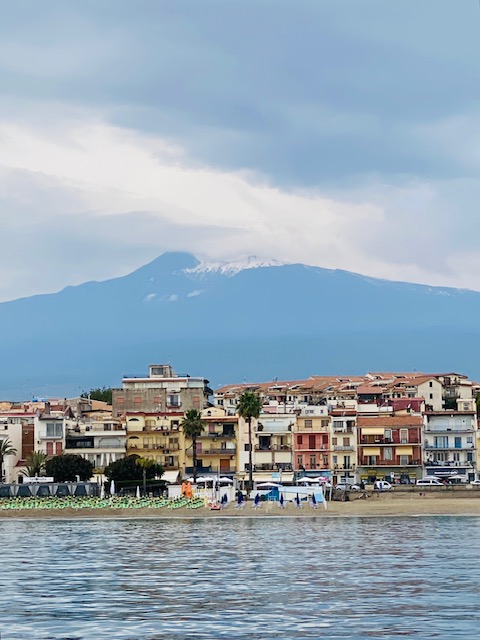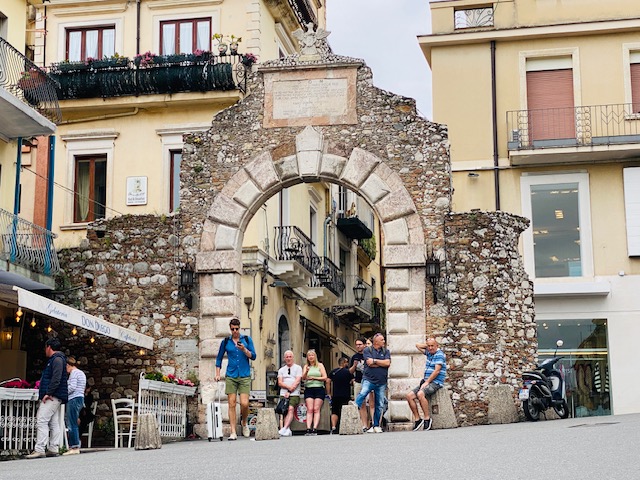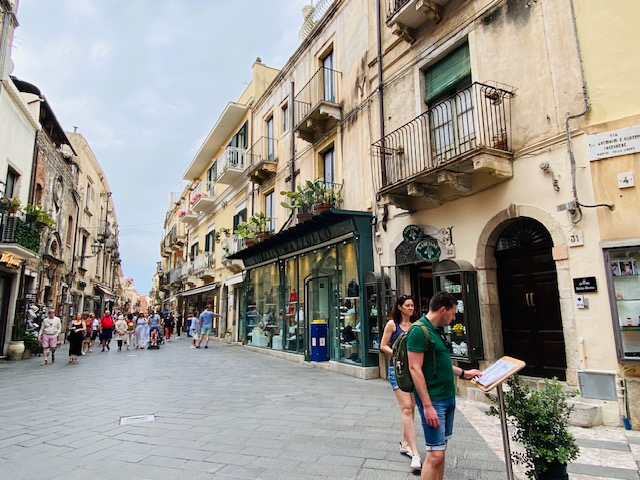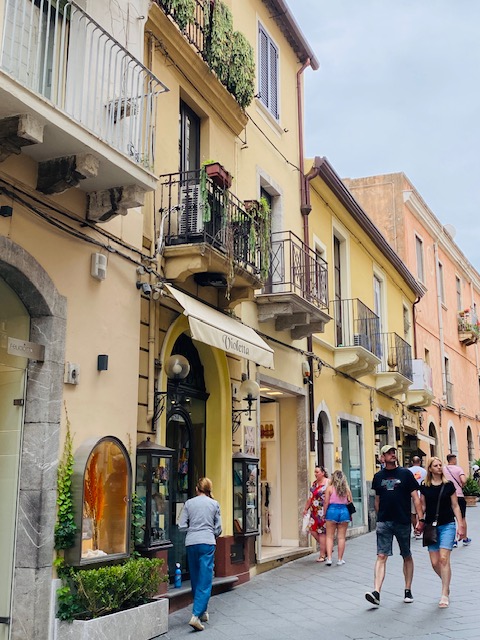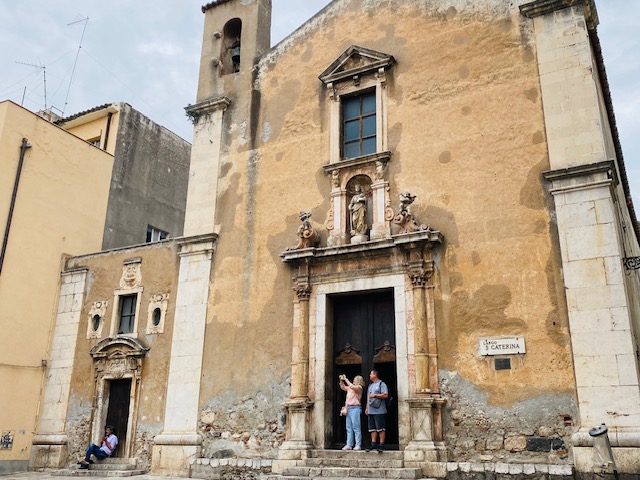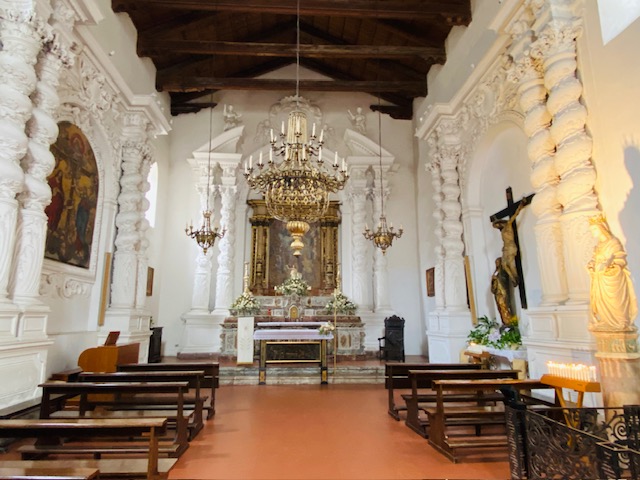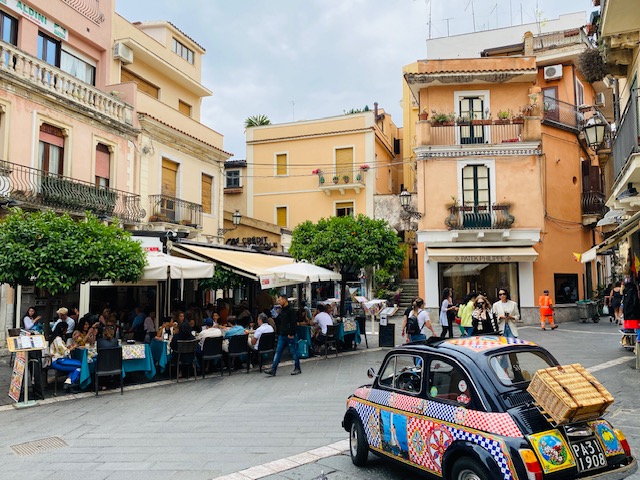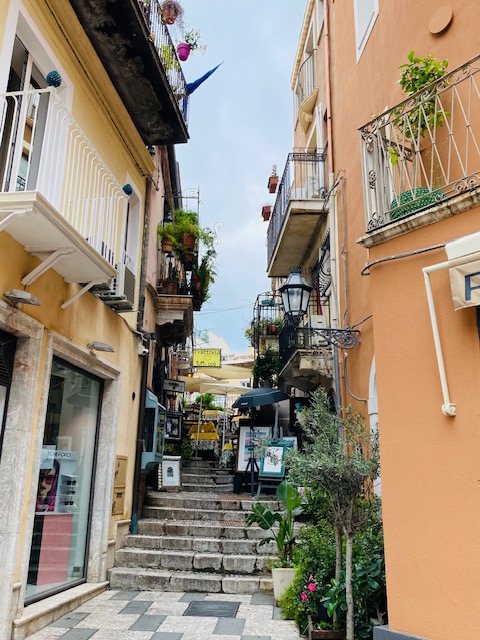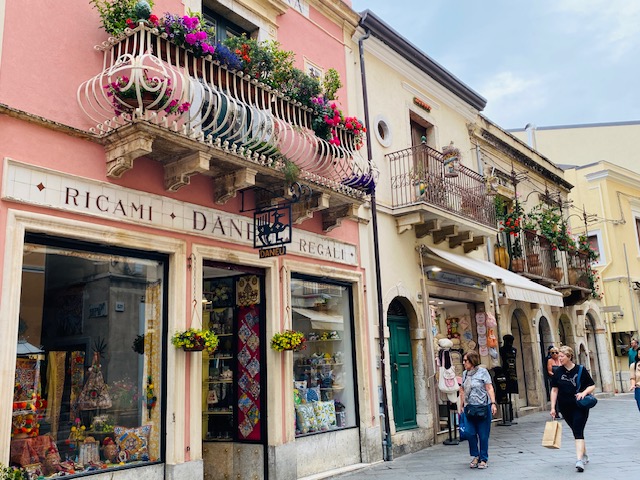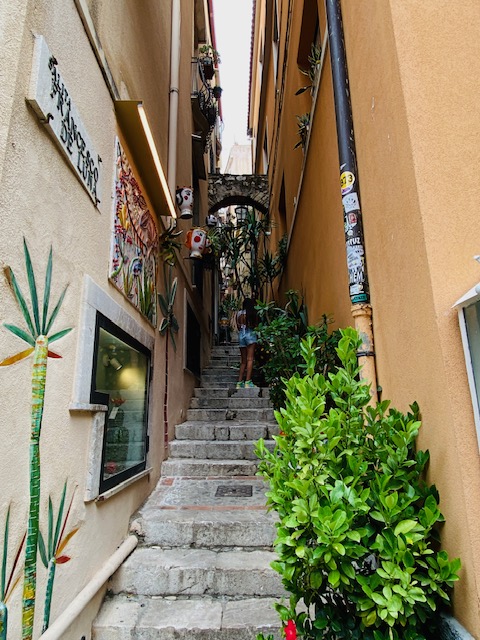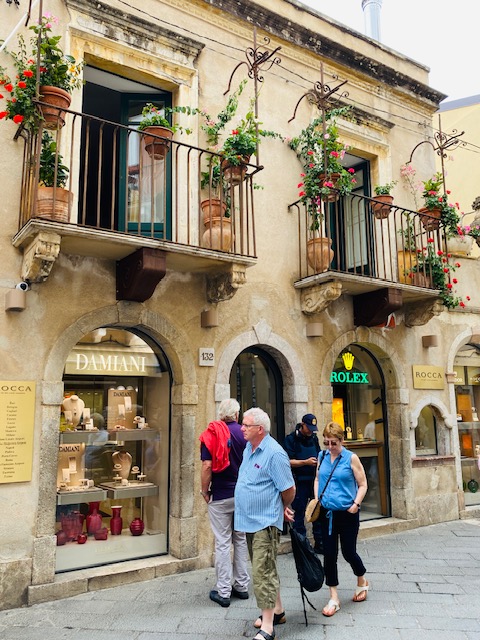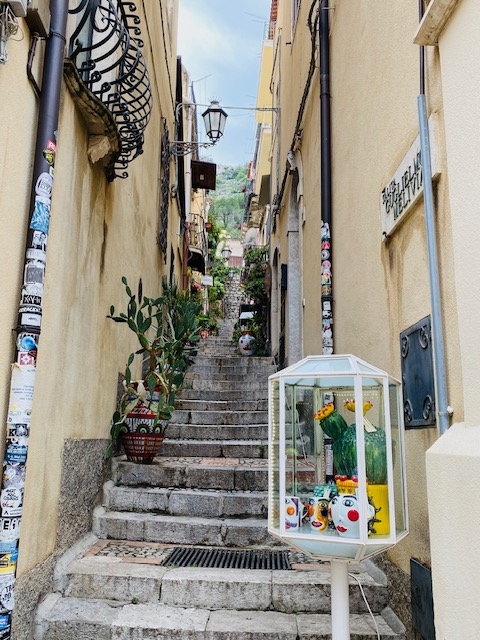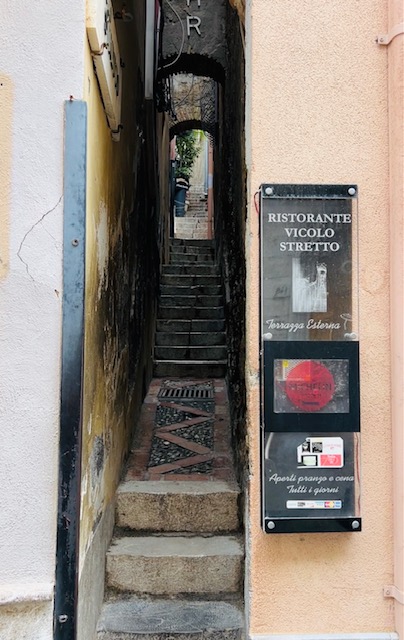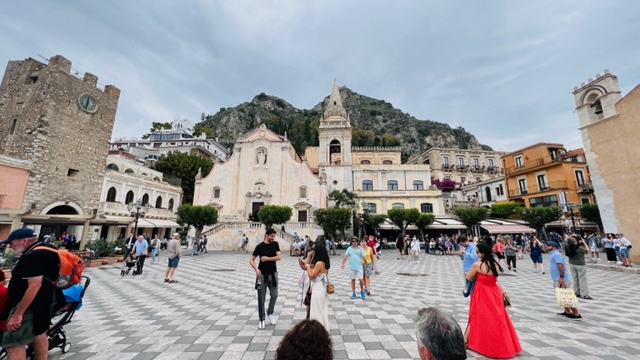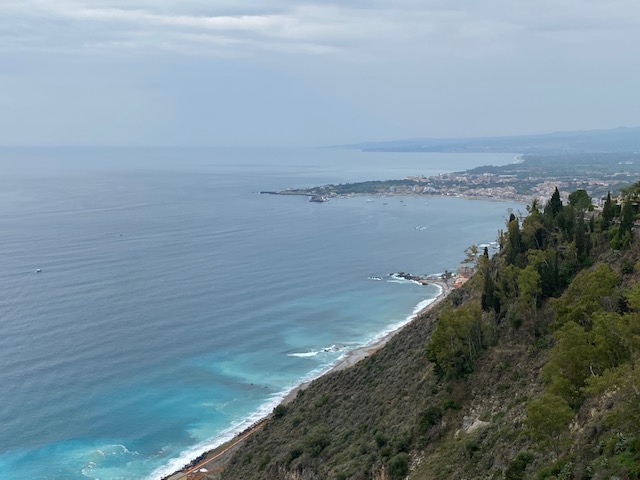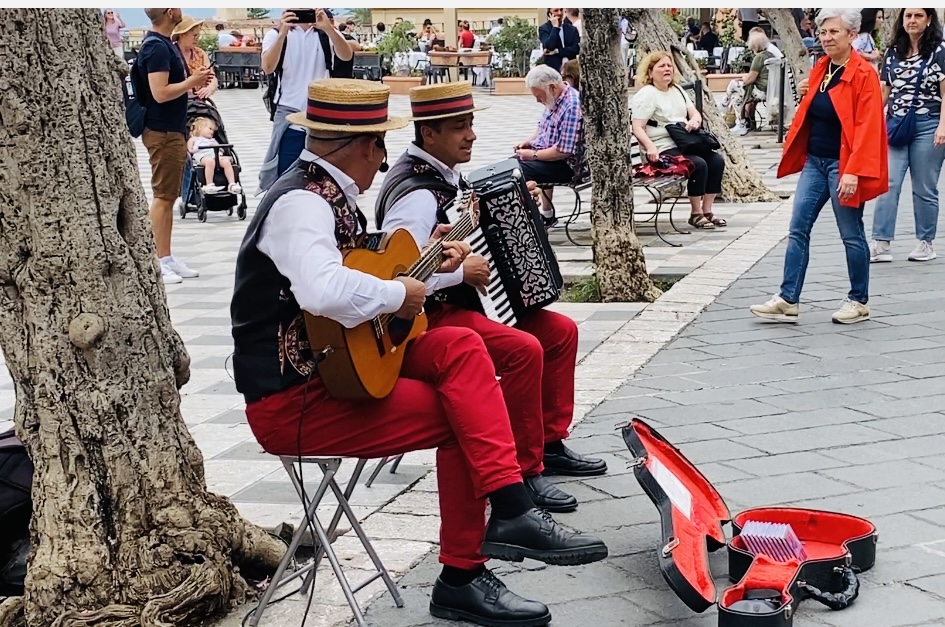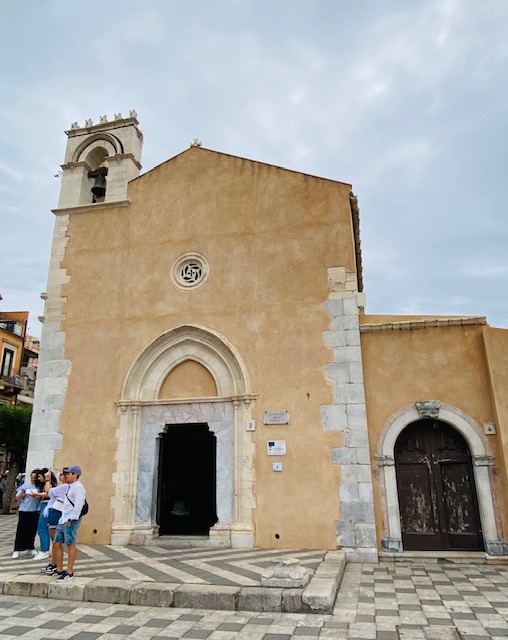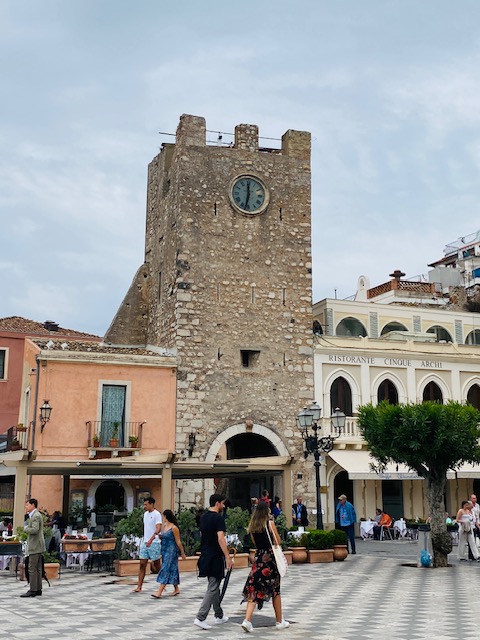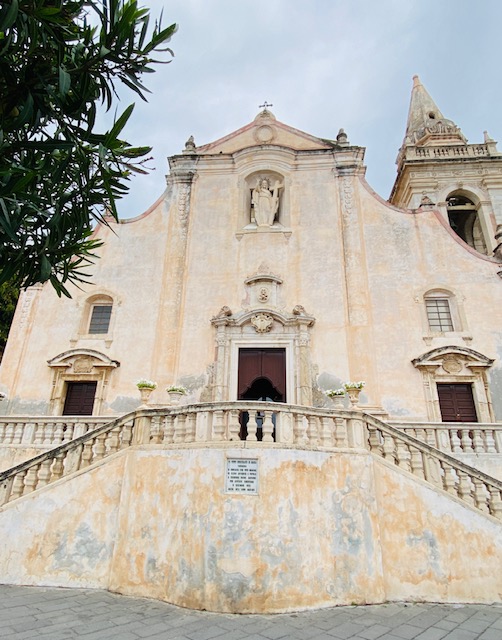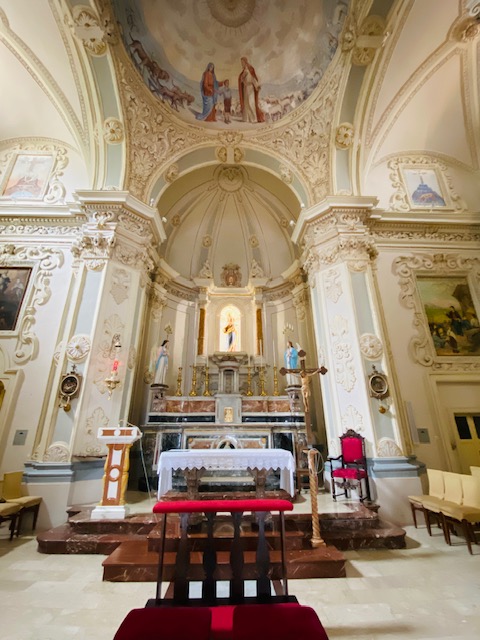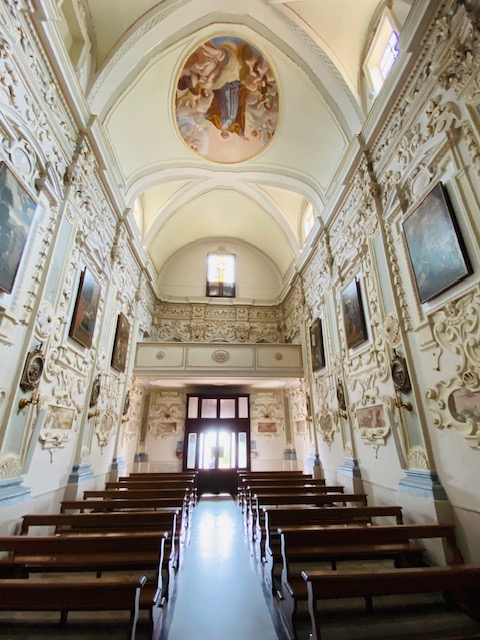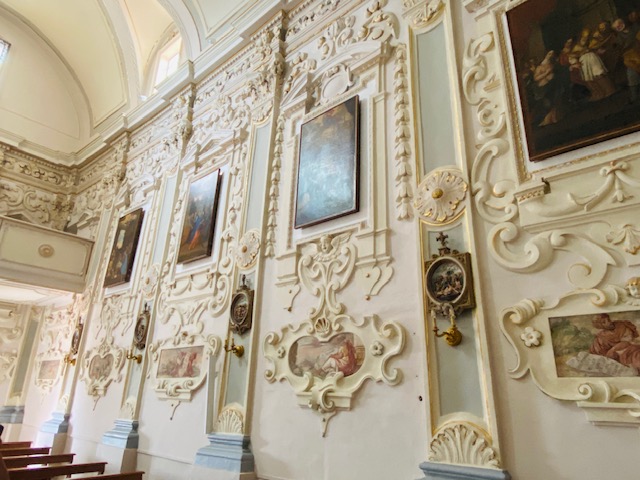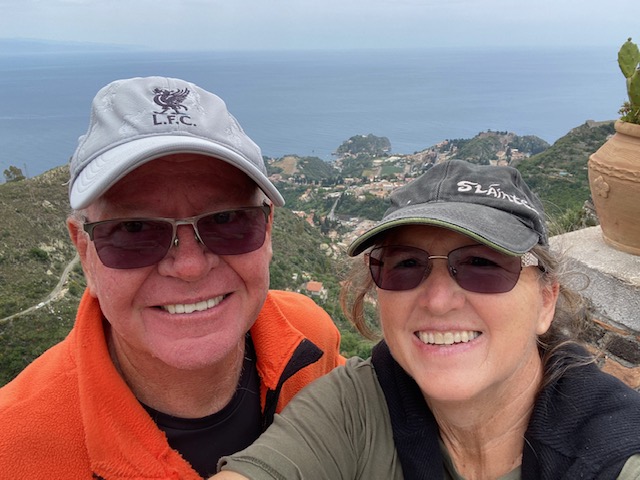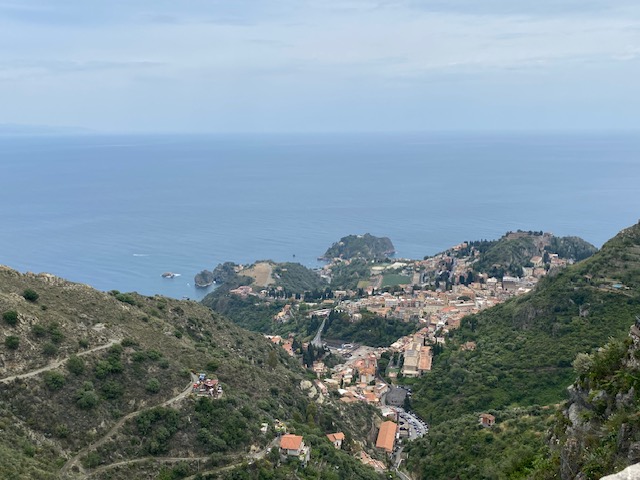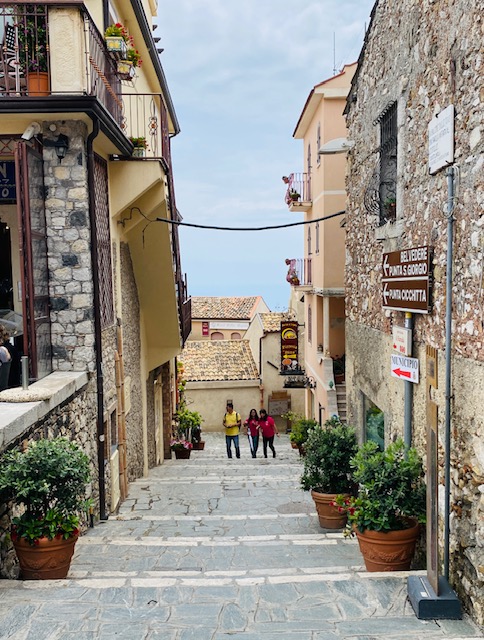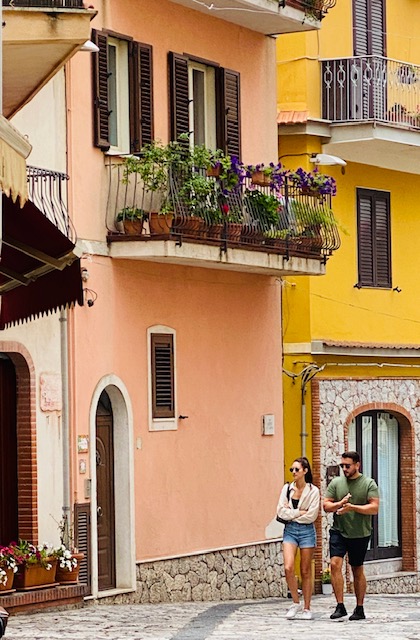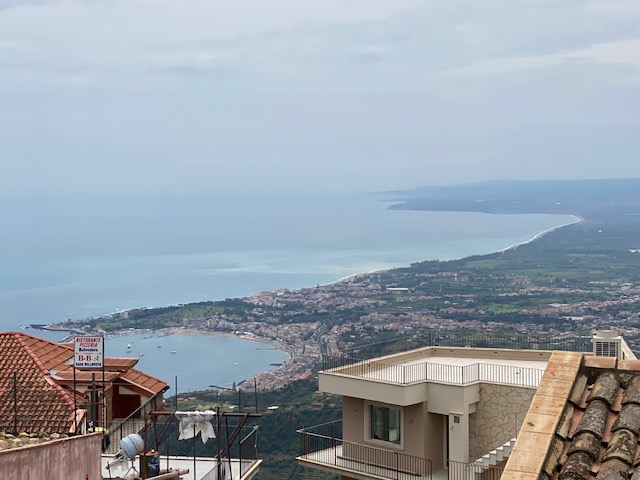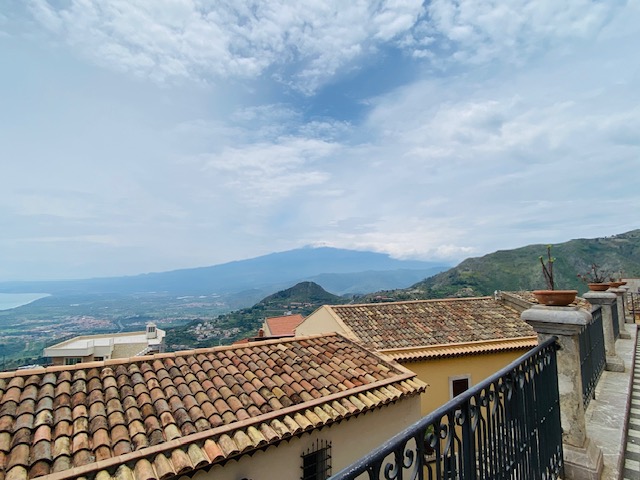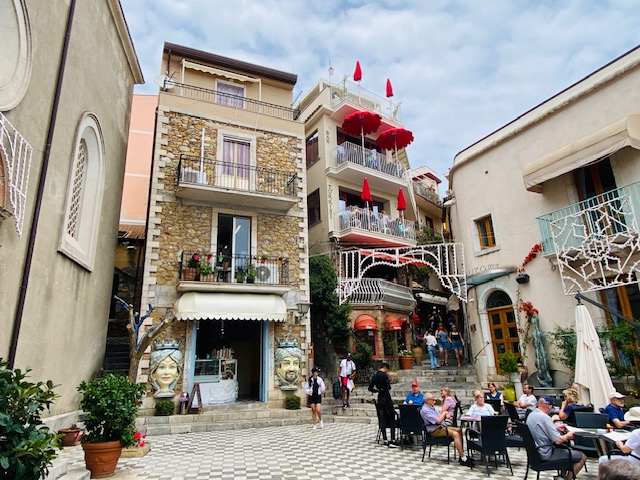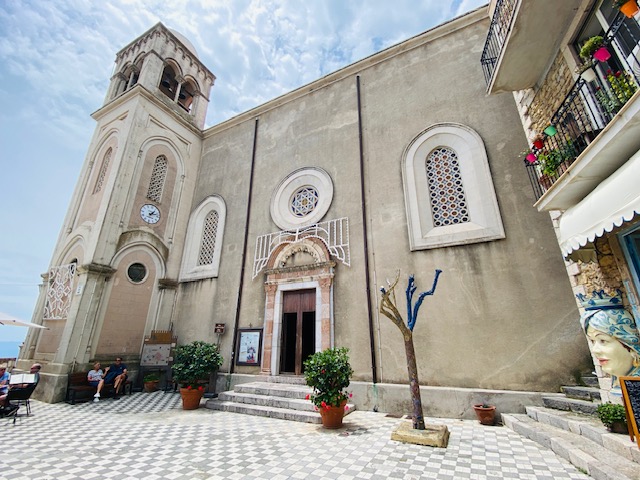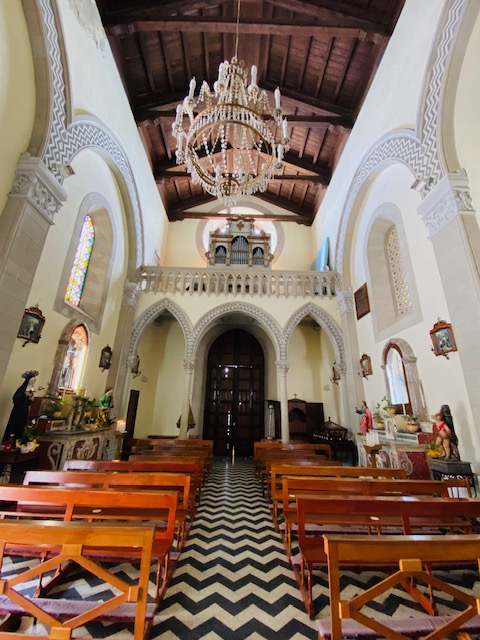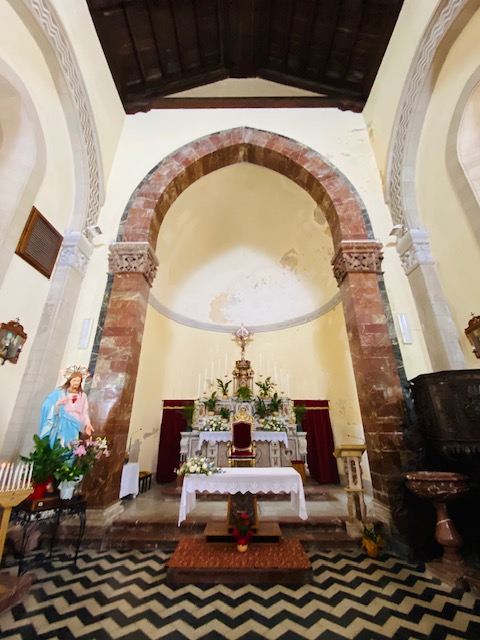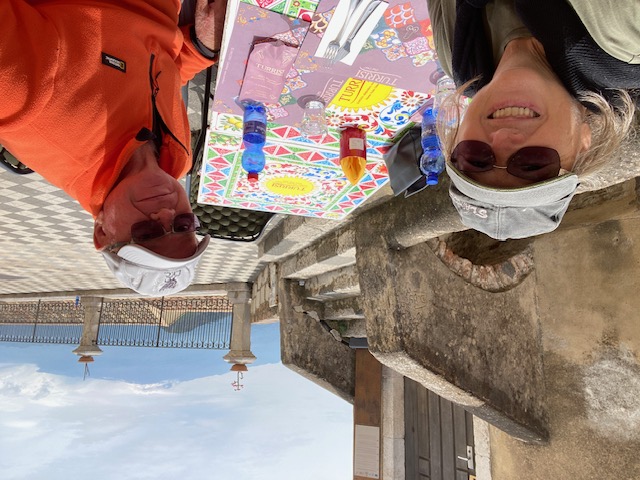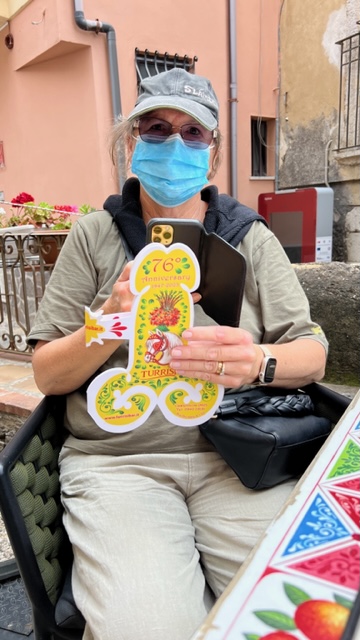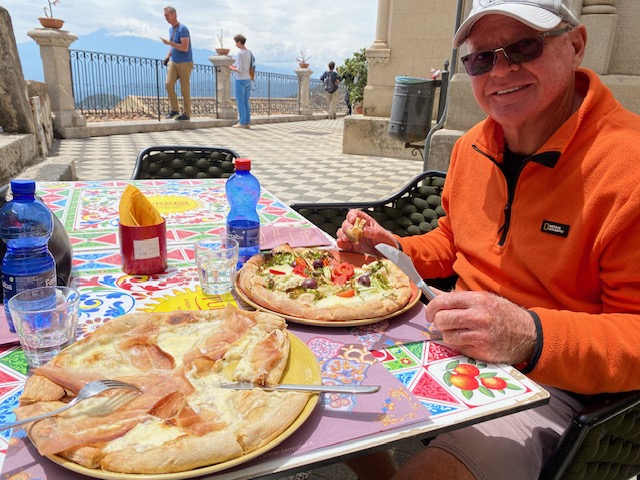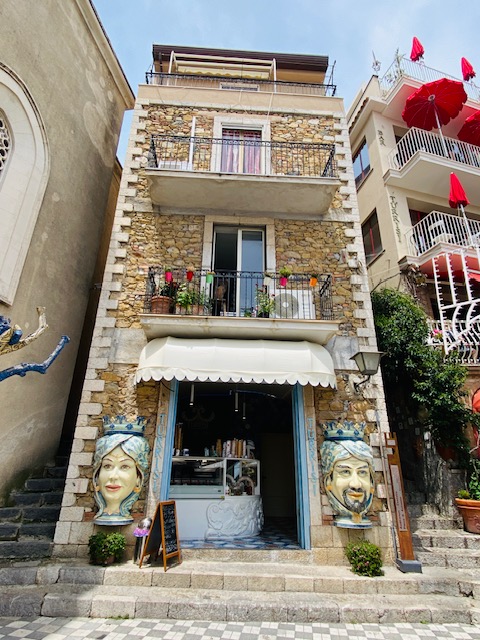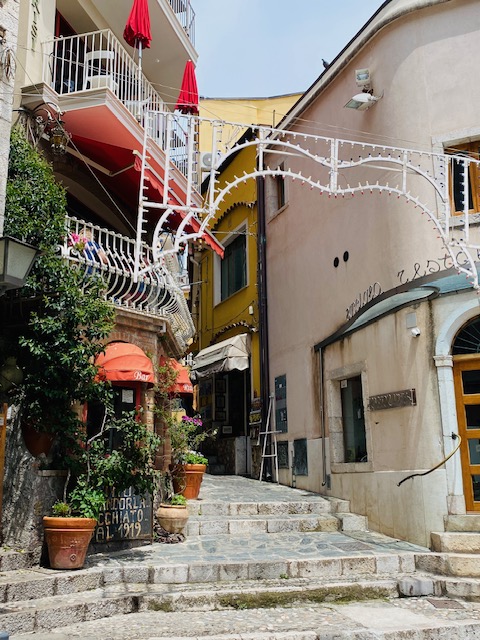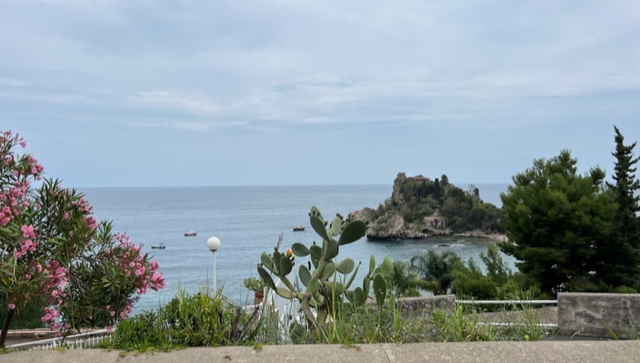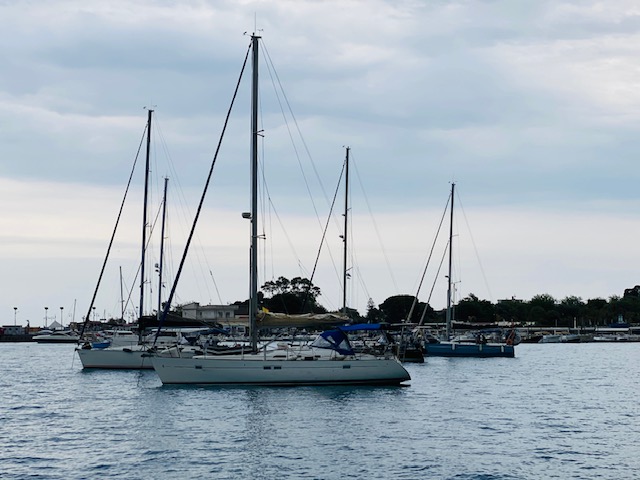Unfortunately, there was also a significant change in the forecast for the weather to the north of Sicily from Wednesday, with an additional Low Pressure system developing off Naples, assisted by northerly winds coming down the east coast of Sardinia and combining with the westerly winds being pushed around the northwestern tip and along the north coast of Sicily by the Low Pressure system to the south of Sicily, reducing our weather window to sail overnight all the way to the Naples area, specifically to Sant’ Angelo on Ischia Island. In other words, it’s yet another cluster of monumental proportions, which changes by the day. Not one forecast is accurate for more than 24 hours and even then it changes. So frustrating!
This, of course, resulted in a change to our revised plan one day into it, assuming the conditions materialise, but hopefully we can still continue moving in a northwesterly direction in order to get to Sardinia at some point in the not too distant future.
It’s fair to say, all of this would not necessarily be a showstopper if there were a selection of decent, well protected anchorages for these constantly varying conditions, but there aren’t and getting a reservation in a marina, is difficult too, especially for a rather beany catamaran like Paw Paw; either they don’t have space or they don’t respond to any written communications, assuming, of course, that you can actually find their contact details to request a reservation.
After breakfast, however, the first matter of today was to rectify a few issues that had cropped up on Paw Paw yesterday. Firstly Roy discovered that the bottom shelf of the port forward cabin was wet and had dampened his clothes, in particular, one of his swimsuits and a rushguard, which was only noticed because he had to jump in the water yesterday evening to clean our depth sensor and check for blockages in all our throughhulls, particularly the watermaker throughhull, since that had suddenly stopped producing water en route.
So, while Roy hunted for the leak, Elaine emptied out his cupboard to dry his damp clothes. Fortunately it didn’t take long to find the leak on the accumulator o-ring of the freshwater pump. Once that was fixed, when checking the watermaker, he discovered that the saltwater lift pump was full of air. We’ll know tomorrow if clearing that resolved the issue.
Afterwords we dinghied ashore to Taormina Beach, the latter word used rather loosely and to be honest, one would have to be desperate to want to lie on it; it was nothing but pebbles and rocks and only freezing water to swim in.
The next hurdle was getting to the road, to walk to the little town of Villagonia, to stretch our legs and to enjoy a coffee and a baked delight. This proved to be something of a maze as we negotiated tunnels, steps and a very busy road without any pavements or sidewalks, requiring us to press ourselves up against the closest building every time a vehicle passed and we weren’t the only people having to do this; their were numerous pedestrians having to take their lives in their hands along this road without an alternative route, including all the folks arriving by rail at the historic railway station and tourists pulling suitcases down the road looking for their hotel.
By the time we reached the “supermarket” and scratched our way through the pitiful fresh produce supply, we were both missing the fabulous fresh produce markets in Samoa, Fiji, Vanuatu , New Caledonia and Türkiye, as well as the fabulous grocery stores and healthy foods of New Zealand, Australia and SE Asia. Throughout our circumnavigation, up until we reached Türkiye, the fruit and vegetables we purchased tasted like the fruit and vegetables that they were, not some tasteless, bitter mockup.
On our return walk, we stopped for lunch at Puerto Rico Beach Club and had the most expensive mouthful of salad yet; Elaine’s literally had two very thin slices of tomato on a bed of iceberg lettuce and a blob of mozzarella cheese on the side with about 6 olives for €16. Roy’s wasn’t much better, but had very rubbery octopus added for €18. What a rip off! We had a beautiful view, though, overlooking the bay where Paw Paw was anchored. Trying to remain grateful for our cruising lifestyle, we had to remind ourselves that many people would love to be sitting in that very expensive restaurant with the view we had, overlooking their yacht.
However, if it sounds like we’re not enjoying sailing in the Mediterranean, you would be right. That would be for a host of reasons, but primarily because we’re not actually sailing; we’re motoring. We are, however, enjoying the touring aspects and the fabulous attractions we’ve stumbled upon thus far en route, by sheer chance actually, because we didn’t plan our route to tour, but rather to get west to Gibraltar the quickest possible way, with a minimum number of overnight sails, taking into consideration the prevailing weather conditions in the months we would be sailing through these countries.
All in all our experience in the Mediterranean has thus far been a case of “we’ve had the best, now try the rest” and it just isn’t coming up to snuff at all. Let’s hope it improves!
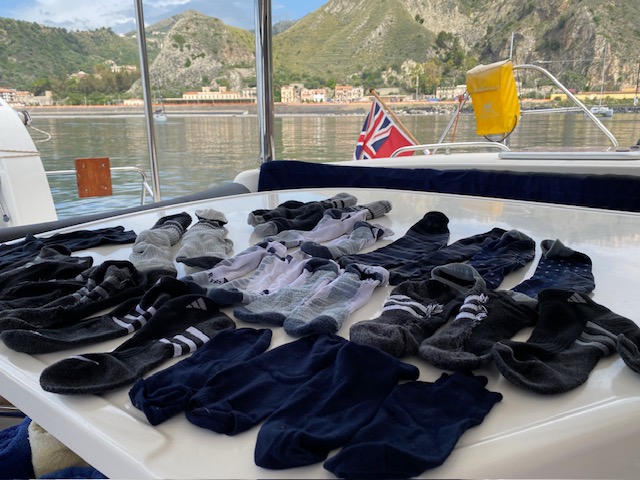

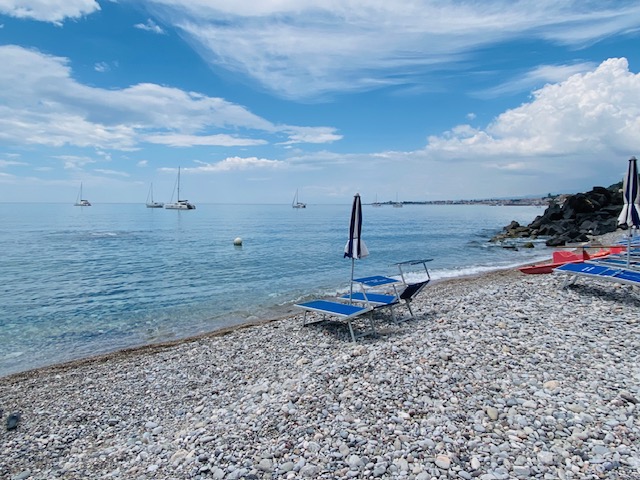
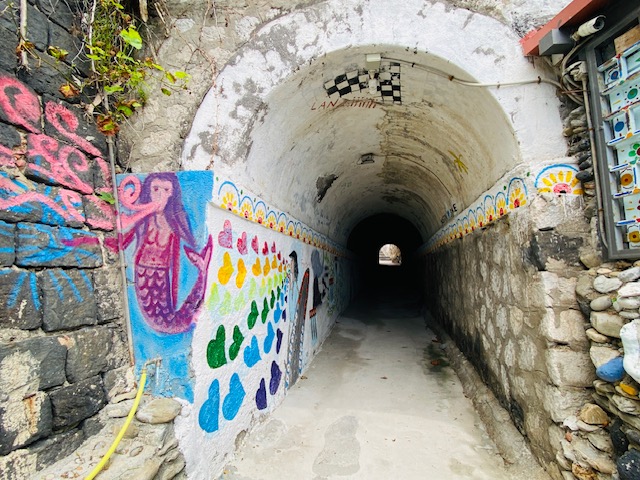

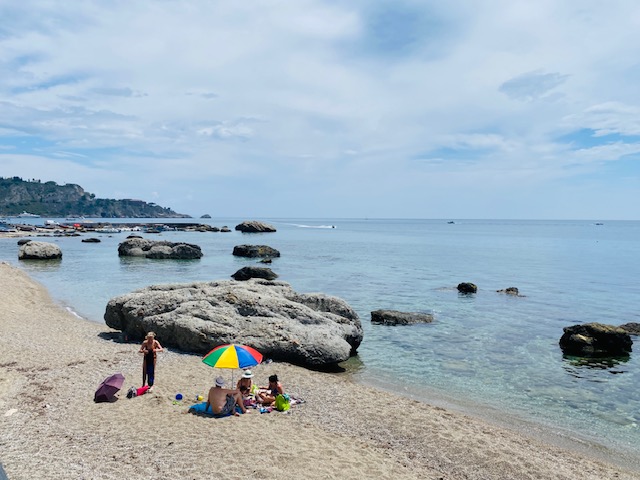
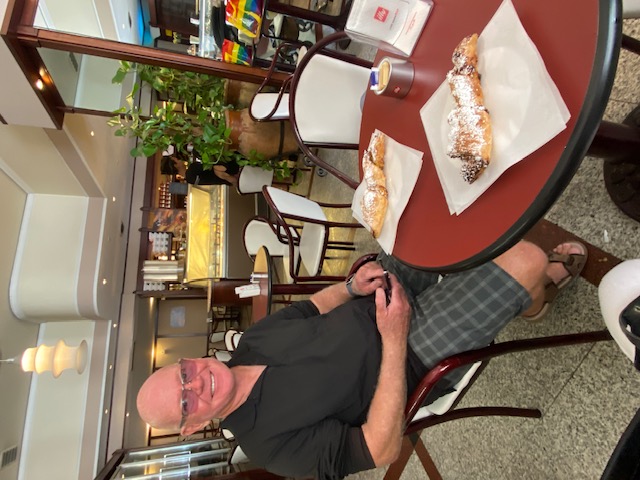

Unfortunately, although we weren’t going backwards ie east, we were, however, going back; to Taormina, to be precise, given our revised route, since it appears to be impossible to safely move along the southern coast of Sicily at this time of the year with the strong westerly winds and the Low Pressure systems continually building between Tripoli and Sicily, making for dangerous sailing conditions, especially when there are no anchorages sheltered from the south along that coast, or indeed offering good protection from the east or the west, with the exception of Licata Marina, which isn’t enough taking into account the distances that need to be sailed. Add the inconsistent and unpredictability of the weather and we decided to rule that route out altogether.
When we first discussed our route through Italy to Sicily then Sardinia, we concluded that we really didn’t want to negotiate the Messina Strait, hence the plan to sail along the southern coast of Sicily, continuing on to the Aegadian Islands, then hopping over to Sardinia to enjoy the southern coast there, before heading over to the Balaerics. It was a fine plan and the shortest route to Gibraltar without doing too many overnights. Well, it’s not meant to be, since the Messina Strait is our only alternative now! While it’s very irritating that this has cost us time and nautical miles, we wouldn’t have had the opportunity to enjoy Syracuse and, really, what’s the point then of sailing if we can’t enjoy the various destinations along the way, even if some turn out to be a minor detour.
To diminish any sense of irritation we may have had, our highlight was a pod of dolphins coming to play in Paw Paw’s bows, the biggest dolphins we’ve seen since leaving the Caribbean and, as always, brought a smile to our faces, especially when one decided to showoff to us. Brilliant!
With the wind from the northwest and the current against us, we hugged the coast of Sicily as close as possible to reduce the force of the wind on our nose and to make the swell more manageable. It was a slow crawl at 4.8 to 5.4 Kts, but comfortable enough, all things considered. Regardless, it had to be done, in order to stage ourselves in Naxos Bay for the calm weather and then southerlies approaching, to get us through the strait.
By 1400 our SOG (Speed Over Ground) had increased slightly, getting us to 5.7- 6.0 Kts, with the lighter winds, per the forecast, having set in. The trick now was to decide which side of Naxos Bay we would anchor in to try and get the best night’s sleep possible in what proved to be a very rolly and uncomfortable anchorage the last time.
As we approached Naxos Bay, Paw Paw was surrounded with yellow butterflies. The last time this happened was in St Martin, Caribbean, in 2014 after returning from Bonaire, where we had spent our first hurricane season.
By 1700 we were anchored back in Naxos Bay, but at the northern end, given the direction of the wind and the swell that hadn’t changed. Being a Sunday, however, it was party central with local boats and jetskis racing up and down everywhere. Deciding not to anchor amongst the mayhem, we picked a spot further out, but hopefully still protected as best you can be in this bay. Nonetheless, we had a fabulous view to enjoy.
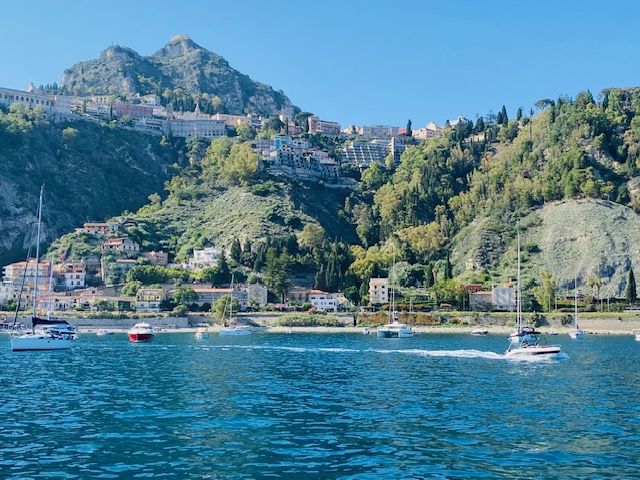
The highlight of the day was waking to a video of William singing at a karaoke with his Nana and Papa, Brooke’s parents. It was so cute, making us think that the Irish in him was coming out and that he may well be following in his Great-Granda’s footsteps, Elaine’s dad.
After breakfast, Elaine cut Roy’s hair, since he was starting to look rather bedraggled, following which we dinghied ashore to enjoy our morning, strolling the streets of Syracuse, or indeed of Ortygia Island, primarily to see the statue of Archimedes that sits over the water between the bridges that join Ortygia Island to Sicily.
The base of the statue was designed to depict the stomachion with 17,152 different possible arrangements of the pieces, one of the first studies of geometrical combinatorics, the branch of mathematics that studies the enumeration, combination, and permutation of sets of elements and the mathematical relations that characterise their properties; one of Archimedes’ main research tools.
Engraved in the base were the symbols that represented Archimedes’ most famous theories, including Pi, the symbol of squaring the circle, encapsulated in Euclidean geometry and the relationship between the circumference and the diameter of a circle.
Linked to this was one of his greatest intuitions concerning the problem of irrational numbers and being able to carry out calculations with very large numbers, for example in astronomy, becoming a pioneering prototype of modern measure theory, as he states that: “Any arbitrarily large or small quantity can be measured starting from any unit of measure”.
In the symbol of Archimedes' planetarium, also linked to the field of astronomy, he developed a theory on the distance of the planets, calculating the apparent diameter of the moon, the sun and the dimensions of the earth.
“The truncated icosahedron symbol, Archimedes' most famous non-regular polyhedron, contains the laws of stereometry and a vision of the world through a geometric texture. This is undoubtedly the most popular solid, the classic soccer ball; an almost spherical surface made up of 12 pentagons, surrounded by 20 hexagons.”
From there we strolled back to “La Piazza Duomo”, to people-watch over a coffee and baked delight. At least, this time, Elaine had something to eat that she recognised; a chocolate filled pastry similar to a croissant.
Wandering back to the marina, we passed Mazzone, a “Specialità Dolciaria” (Specialised Confectionary), where we couldn’t resist the nougat and “nut brittle”, the former the most authentic confectionery tradition in Sicily, made using ancient knowledge handed down from generation to generation by the masters and containing ingredients that are exclusively typical products of the island: almonds, pistachios, honey, egg white and sugar.
When we returned to Paw Paw and following another perusal of the weather, we spent the rest of the afternoon finalising our new route and anchoring options.
That left time before dinner to call Elaine’s folks then Justine and Paul; it had been a while, so there was plenty to catch up on.
And, with that, our day came to a close.








After fetching Roy, Elaine sanitised and stow all our purchases, while Roy set off in the dinghy again; his final diesel run to completely fill the tanks.
After lunch and before a nap, the winds picked up out of the southern sector at 10-15 Kts, as forecast, giving us some confidence in the data for the next few days.
SOS Humanity, a German flagged search and rescue ship, dedicated to saving refugees and asylum seekers from drowning while crossing the Mediterranean Sea, had joined Ocean Viking in the anchorage, a Norwegian flagged ship with the same mission, bringing home the humanitarian crisis Europe and the UK are facing. What was rather distressing, though, was Roy’s experience this morning on how many people were living in squalor in an encampment northeast of the anchorage and had us wondering whether or not these ships were escorting these people to Germany and Norway respectively or simply dropping them ashore in Italy or any other Mediterranean country that would accept them, negating the point of them leaving their homes and their loved ones to end up in the same conditions they left, having gained nothing and only served to benefit the people traffickers.
Setting these dismal thoughts aside, we dinghied ashore early evening to enjoy a few more historical sites, including the “Tempio di Apollo” (Temple of Apollo) and the “Fontana di Diana” (Fountain of Diana), passing “Chiesa San Paolo” (Church of St Paul) on the way, before enjoying a sundowner at Caffè Minerva just off “La Piazza Duomo”, followed by an authentic Italian meal at Ristorante La Volpe e L'uva overlooking “Duomo di Siracusa” (Cathedral of Syacuse).
The “Tempio di Apollo” is considered one of the most important Ancient Greek monuments on Ortygia Island, which sits on “Piazza Pancali” and dates back to the 6th Century BC. It is one of the most ancient doric temples and amongst the first with the layout consisting of a peripteros of stone columns, a style where the temple is surrounded by a portico with columns, the principal porch or entrance to the temple, roofed and open to the sides.
The temple underwent several transformations over the centuries until it was eventually incorporated into a 16th Century Spanish barracks and private houses before the remains were rediscovered and excavated in 1890.
“Fontana di Diana”, built in 1906 on the second most important square on the island, “Piazza Archimede” is inspired by the myth of Alphaeus and Arethusa, the latter associated with the fountain we stumbled upon yesterday, “Fonte Arethusa”. The sculptor depicts the nymph, Arethusa, protected by her mother, Diana, goddess of the hunt, as she flees from the god, Alphaeus.
For us, though, it was an enjoyable evening stroll around the ancient city on a rather blustery day, giving us a break from bouncing around on Paw Paw.














Then it was time to head ashore and explore Syracuse, specifically the historic areas on Ortygia Island, but not before we found a delightful little café on one of the back streets, Caffetteria Mastroianni, to enjoy a morning coffee and a baked delight. While Roy had a chocolate filled croissant, Elaine has no idea of what she actually ate; definitely an interesting combination of sweet and savoury.
Fuelled on caffeine and sugar we set off in the direction of the basilica and what a fabulous experience awaited us.
Passing some beautiful buildings along the way as we meandered through the narrow streets and passing a tiny chapel, we came upon “La Piazza Duomo”, the city square, the heart of the historic area, surrounded by magnificent buildings and, in particular, “Duomo di Siracusa” (Cathedral of Syacuse). Having had the opportunity to see amazing architecture and craftsmanship all over the world during our circumnavigation, this cathedral rivalled the best.
The original core of the cathedral, built of limestone and covered with plaster, was constructed in the 5th Century BC as a Greek doric temple, with six columns on the short sides and fourteen on the long sides, dedicated to the goddess, Athena, and, as such, is a UNESCO World Heritage Site.
However, an archeological excavation in 1907-1910 showed that the Greek temple had been built on even older foundations and uncovered a wealth of archaic and pre-Hellenic artefacts, all housed in the Archeological Museum of Syracuse.
The present cathedral was constructed in the 7th Century, incorporating the doric columns of the original temple, which we could see inside and out.
The interior of the church had numerous naves and chapels. There was one, however, where we were not permitted to take photographs, but was exquisite, including the well preserved frescoes on the domed ceilings. One couldn’t escape the ornate opulence and certainly made us wonder about the wealth required to construct such a structure, contrasted against a standard of living the ordinary citizens, or indeed the worshippers, may have had.
Adjacent to the cathedral, at the far southern end of the piazza, was “Chiesa di Santa Lucia alla Badia”, another Roman Catholic church, although now deconsecrated, and an adjoining former monastery. It was another magnificent structure with a beautiful baroque-style interior.
After taking the time to appreciate its interior as well, we stopped for an ice-cream from Gelati Bianca before continuing our wanderings through the back streets and popping out on the waterfront on the eastern side of the city, where we were surprised to find bathers enjoying “Spiaggia Di Cala Rossa” (Cala Rossa Beach); the water must have been freezing!
From there we continued along the waterfront towards “Castello Maniace” (Maniace Castle), situated at the far point of the Ortygia Island promontory, together with the citadel. Having sailed passed it yesterday, it was interesting to see the structure up close, constructed between 1232 and 1240 by the Emperor Frederick II, King of Sicily, but bears the name of George Maniakes, the Byzantine general who besieged and took the city in 1038. Research revealed that King Peter III of Aragon resided here with his family in 1288 and from 1305 to 1536 it was used as a residence by numerous queens of Sicily.
Continuing our stroll along the waterfront on the inside of the bay, we stumbled upon “Fonte Arethusa” (the Fountain of Arethusa) or the Arethusa Spring, a natural spring on the island. According to Greek mythology, this freshwater fountain is the place where the nymph Arethusa, the patron figure of ancient Syracuse, returned to earth's surface after escaping from her undersea home in Arcadia. This fountain, the river Ciane, south of Syracuse, and the river Fiume Freddo in the province of Catania are the only places in Europe where papyrus grows.
This 2,700-year-old city, Syracuse, pronounced “sara’usa”, is the capital of the Italian province of the same name, with its rich Greek and Roman history, culture and architecture, as well as being the birthplace and home of the pre-eminent mathematician and engineer, Archimedes, a statue of whom stands near the marina and town harbour, provided us with another wonderful day of exploring, making all our efforts of hunkering down for bad weather, long motoring days and rolly anchorages to get here, worth the while.
Both relieved to have had a good night’s sleep in a very calm anchorage, without bouncing around all over the place in a terrible swell, after breakfast, Elaine relooked at our route options considering the very unpredictable and unpleasant weather patterns in this part of the world, while Roy did two diesel runs, having eventually found the fuel dock, one we would never consider taking Paw Paw onto.
Then it was time to head ashore and explore Syracuse, specifically the historic areas on Ortygia Island, but not before we found a delightful little café on one of the back streets, Caffetteria Mastroianni, to enjoy a morning coffee and a baked delight. While Roy had a chocolate filled croissant, Elaine has no idea of what she actually ate; definitely an interesting combination of sweet and savoury.
Fuelled on caffeine and sugar we set off in the direction of the basilica and what a fabulous experience awaited us.
Passing some beautiful buildings along the way as we meandered through the narrow streets and passing a tiny chapel, we came upon “La Piazza Duomo”, the city square, the heart of the historic area, surrounded by magnificent buildings and, in particular, “Duomo di Siracusa” (Cathedral of Syacuse). Having had the opportunity to see amazing architecture and craftsmanship all over the world during our circumnavigation, this cathedral rivalled the best.
The original core of the cathedral, built of limestone and covered with plaster, was constructed in the 5th Century BC as a Greek doric temple, with six columns on the short sides and fourteen on the long sides, dedicated to the goddess, Athena, and, as such, is a UNESCO World Heritage Site.
However, an archeological excavation in 1907-1910 showed that the Greek temple had been built on even older foundations and uncovered a wealth of archaic and pre-Hellenic artefacts, all housed in the Archeological Museum of Syracuse.
The present cathedral was constructed in the 7th Century, incorporating the doric columns of the original temple, which we could see inside and out.
The interior of the church had numerous naves and chapels. There was one, however, where we were not permitted to take photographs, but was exquisite, including the well preserved frescoes on the domed ceilings. One couldn’t escape the ornate opulence and certainly made us wonder about the wealth required to construct such a structure, contrasted against a standard of living the ordinary citizens, or indeed the worshippers, may have had.
Adjacent to the cathedral, at the far southern end of the piazza, was “Chiesa di Santa Lucia alla Badia”, another Roman Catholic church, although now deconsecrated, and an adjoining former monastery. It was another magnificent structure with a beautiful baroque-style interior.
After taking the time to appreciate its interior as well, we stopped for an ice-cream from Gelati Bianca before continuing our wanderings through the back streets and popping out on the waterfront on the eastern side of the city, where we were surprised to find bathers enjoying “Spiaggia Di Cala Rossa” (Cala Rossa Beach); the water must have been freezing!
From there we continued along the waterfront towards “Castello Maniace” (Maniace Castle), situated at the far point of the Ortygia Island promontory, together with the citadel. Having sailed passed it yesterday, it was interesting to see the structure up close, constructed between 1232 and 1240 by the Emperor Frederick II, King of Sicily, but bears the name of George Maniakes, the Byzantine general who besieged and took the city in 1038. Research revealed that King Peter III of Aragon resided here with his family in 1288 and from 1305 to 1536 it was used as a residence by numerous queens of Sicily.
Continuing our stroll along the waterfront on the inside of the bay, we stumbled upon “Fonte Arethusa” (the Fountain of Arethusa) or the Arethusa Spring, a natural spring on the island. According to Greek mythology, this freshwater fountain is the place where the nymph Arethusa, the patron figure of ancient Syracuse, returned to earth's surface after escaping from her undersea home in Arcadia. This fountain, the river Ciane, south of Syracuse, and the river Fiume Freddo in the province of Catania are the only places in Europe where papyrus grows.
This 2,700-year-old city, Syracuse, pronounced “sara’usa”, is the capital of the Italian province of the same name, with its rich Greek and Roman history, culture and architecture, as well as being the birthplace and home of the pre-eminent mathematician and engineer, Archimedes, a statue of whom stands near the marina and town harbour, provided us with another wonderful day of exploring, making all our efforts of hunkering down for bad weather, long motoring days and rolly anchorages to get here, worth the while.
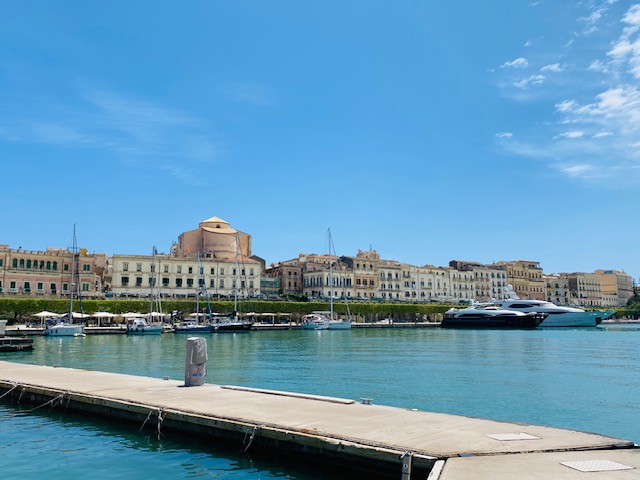
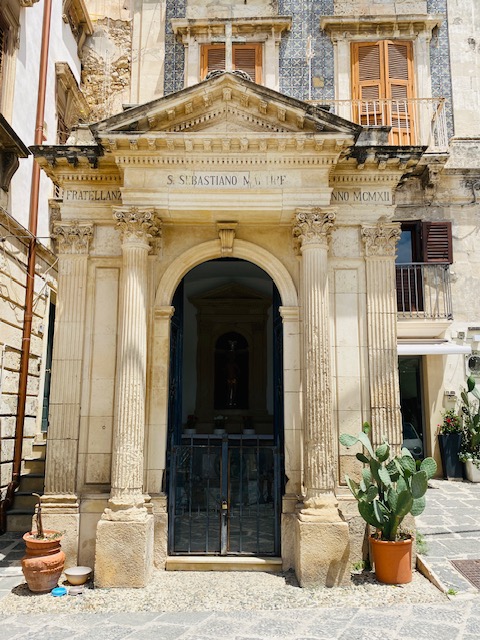
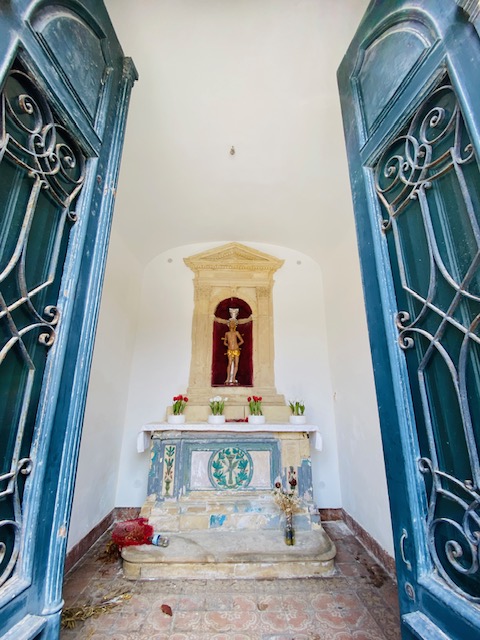
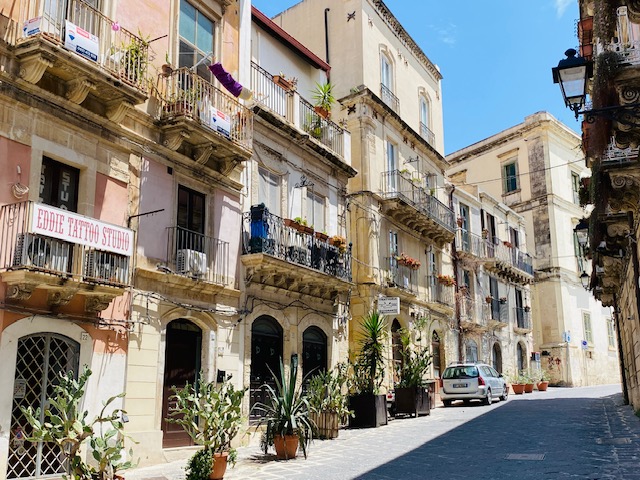
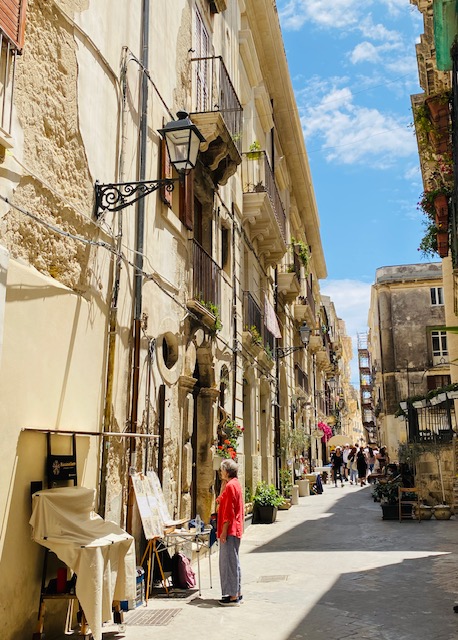
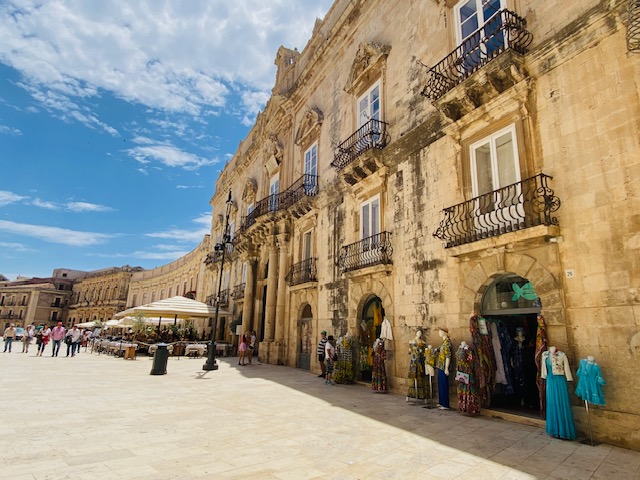
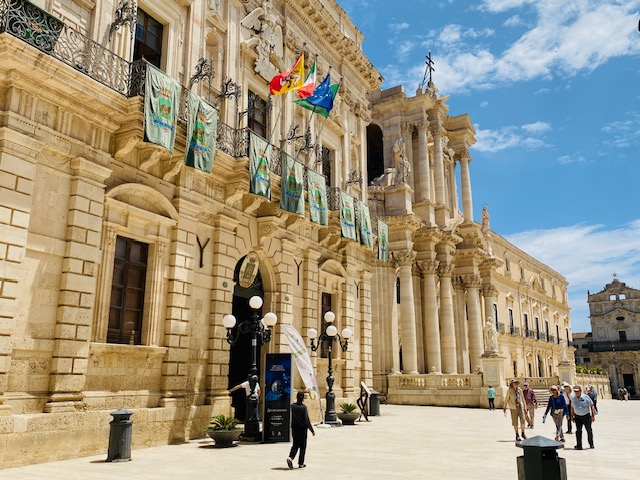
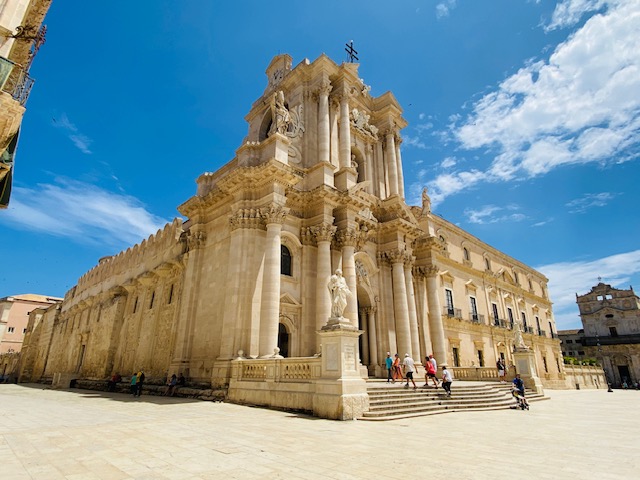
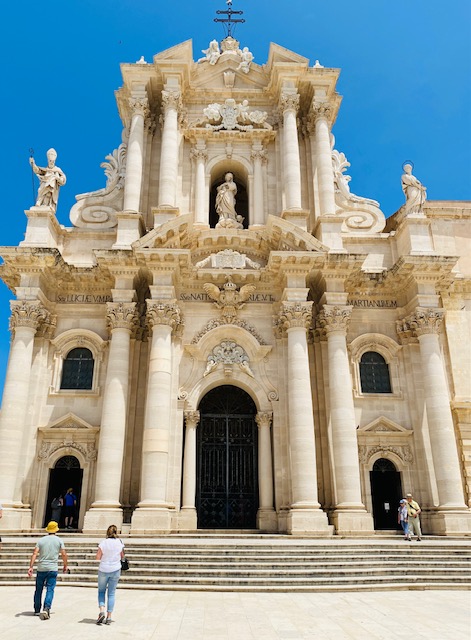
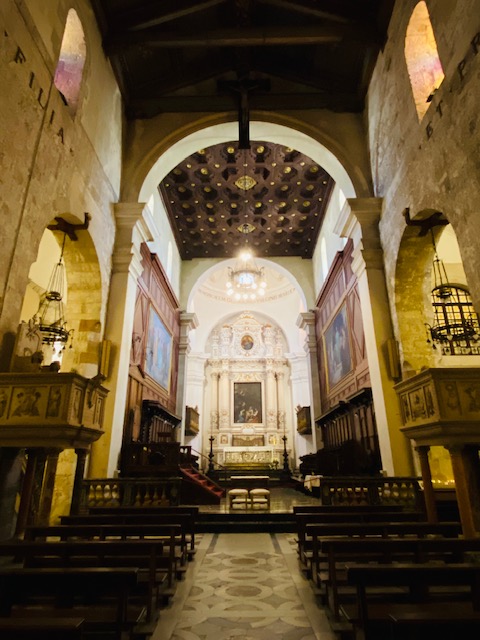
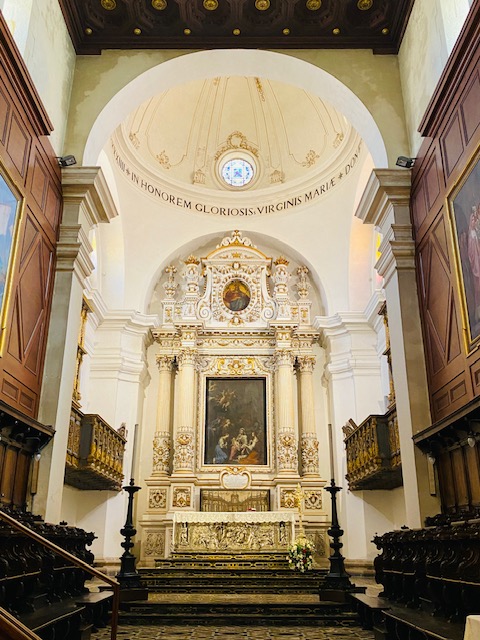
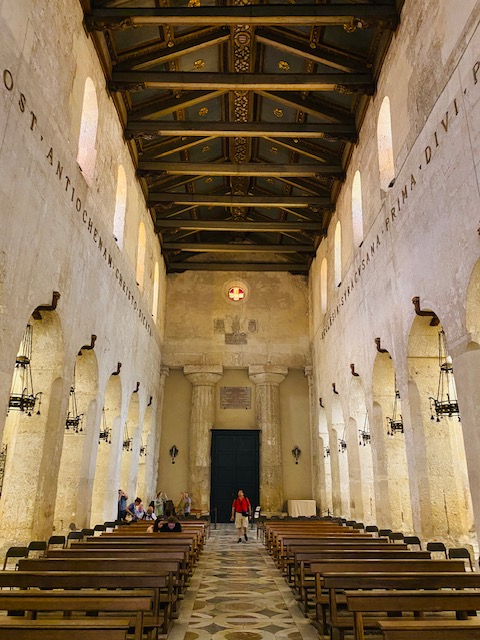
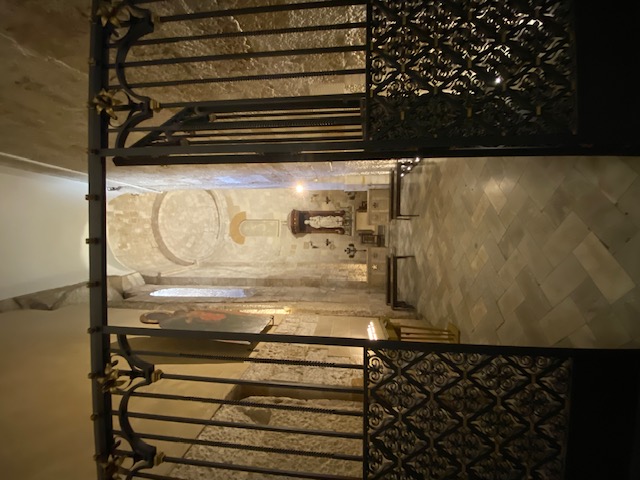
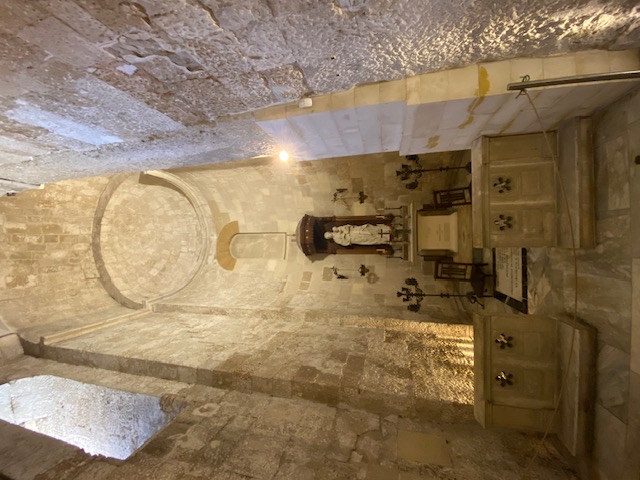
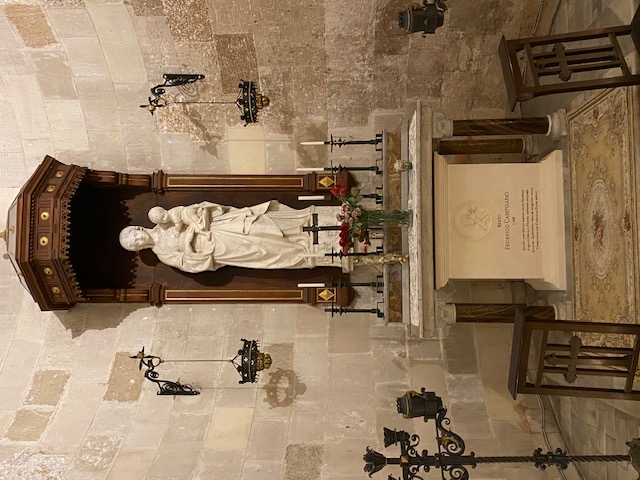
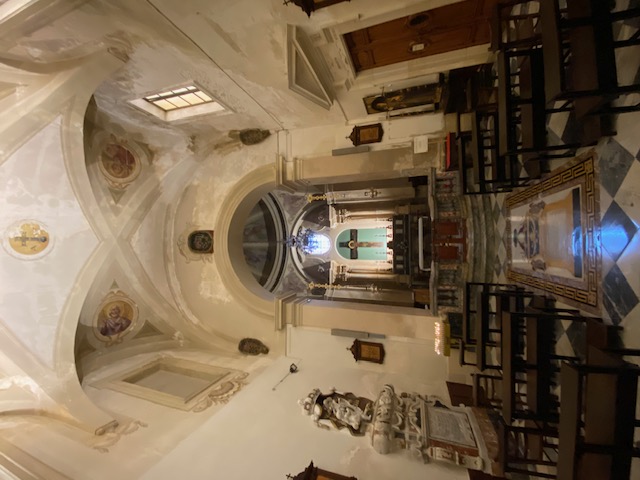
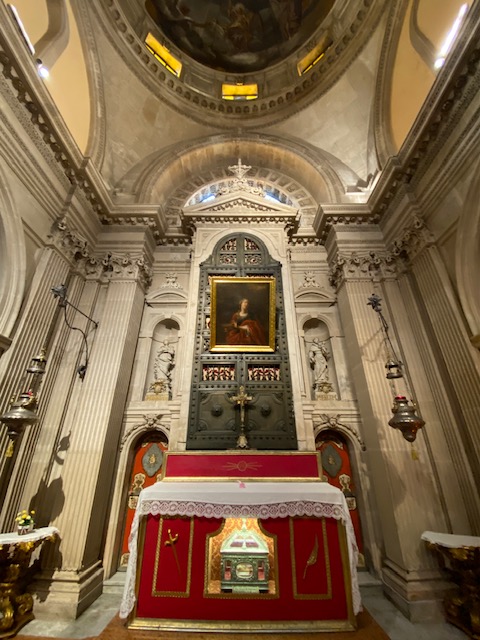
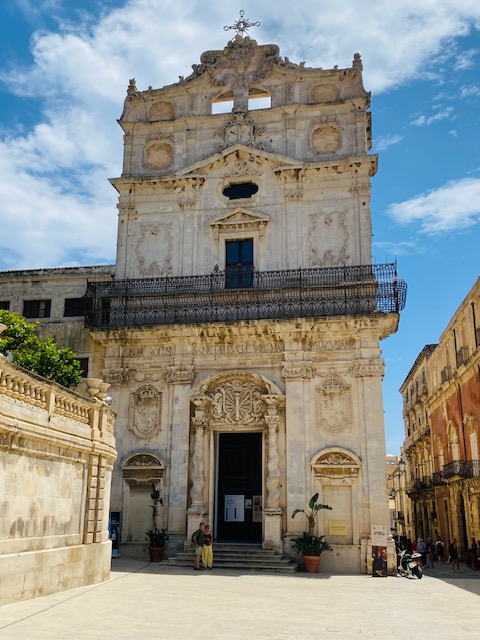
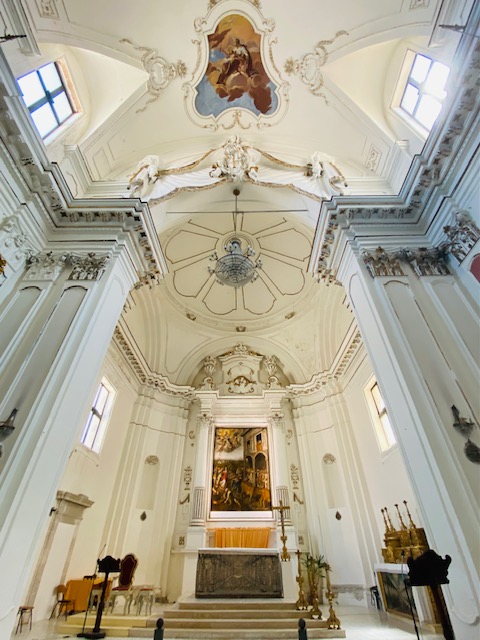
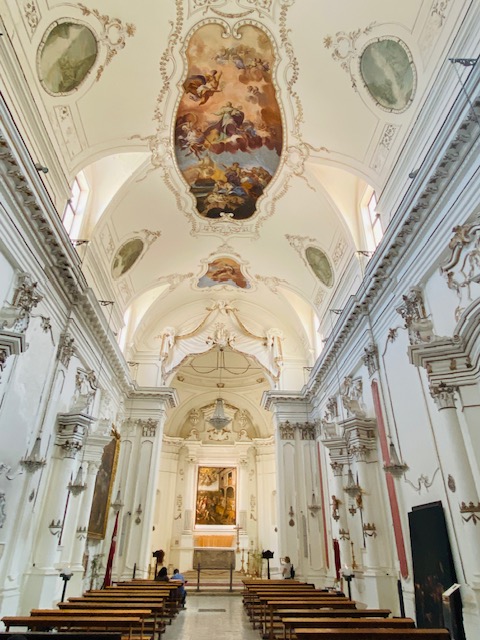
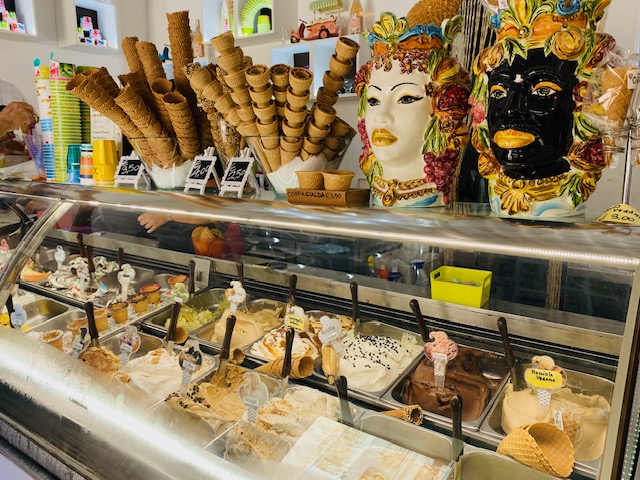
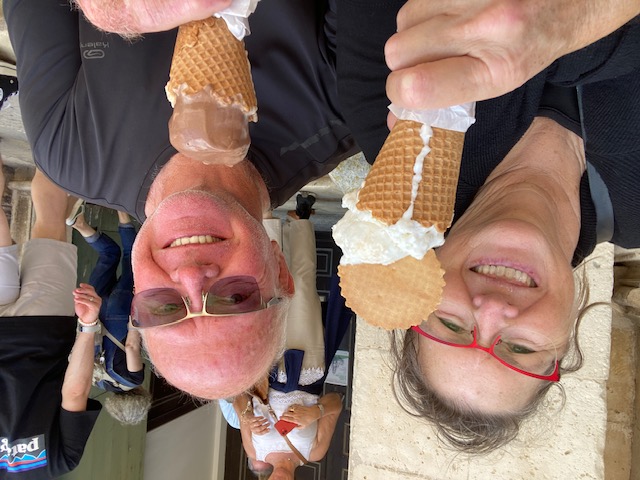
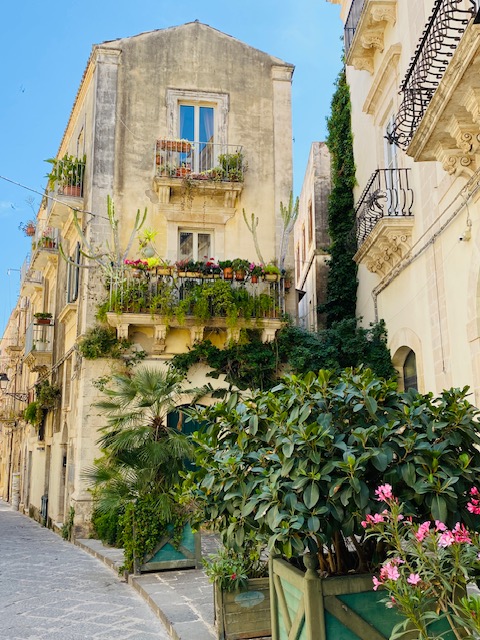
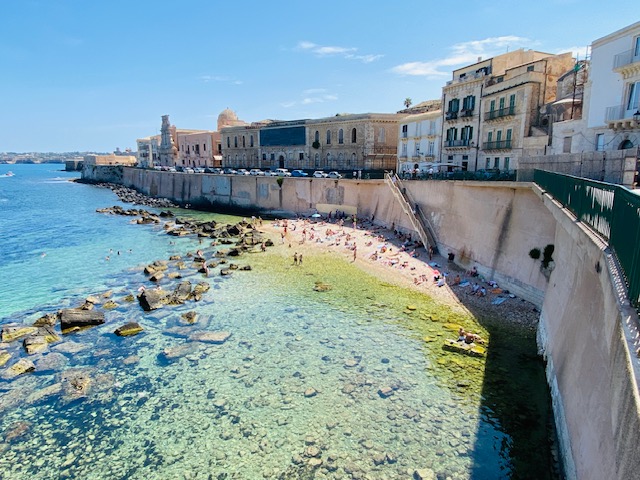
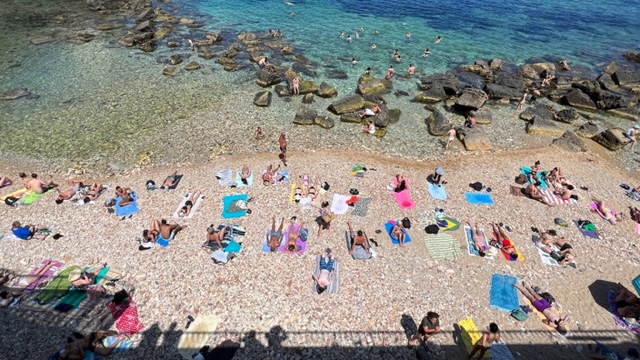
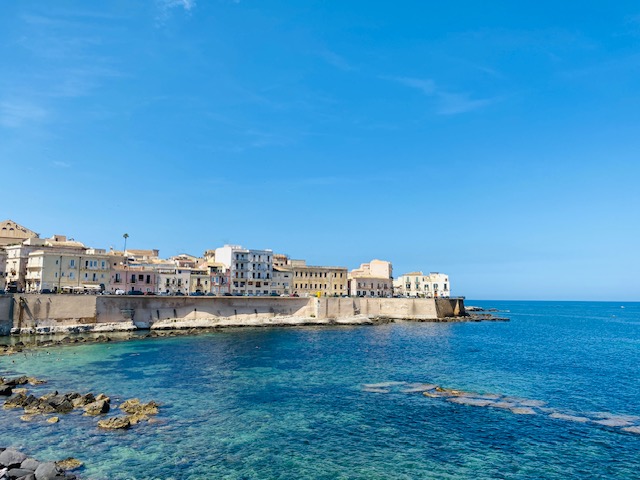
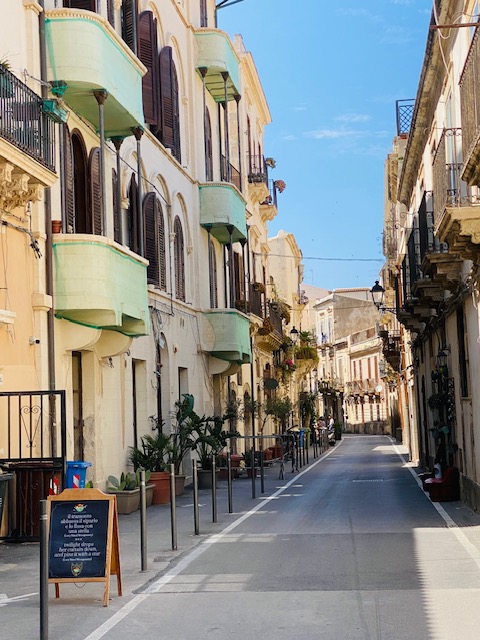
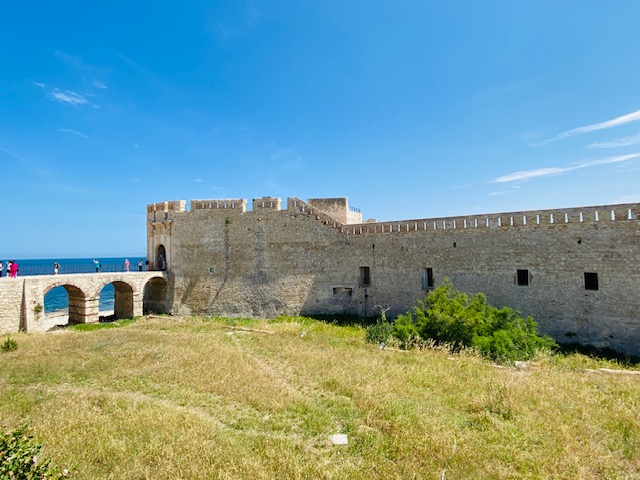
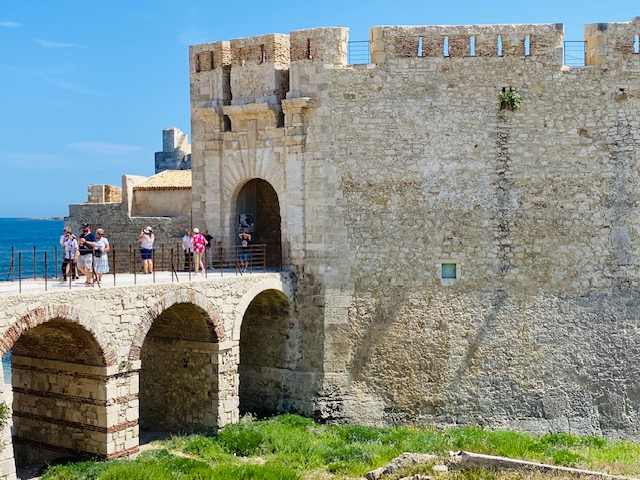
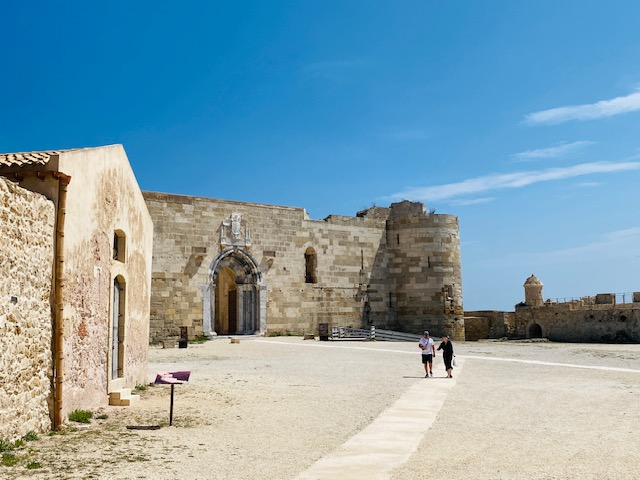
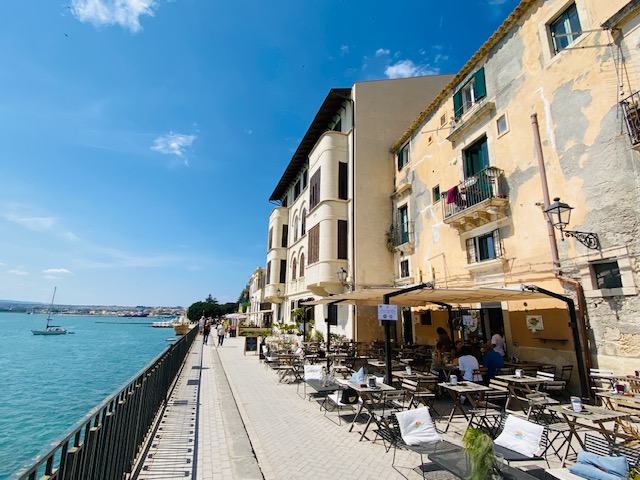
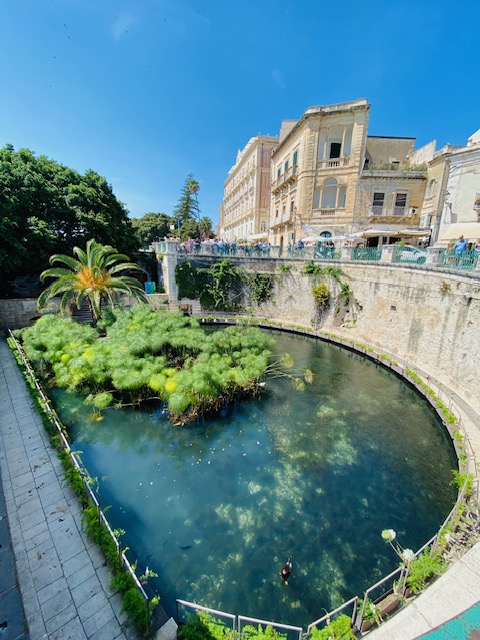
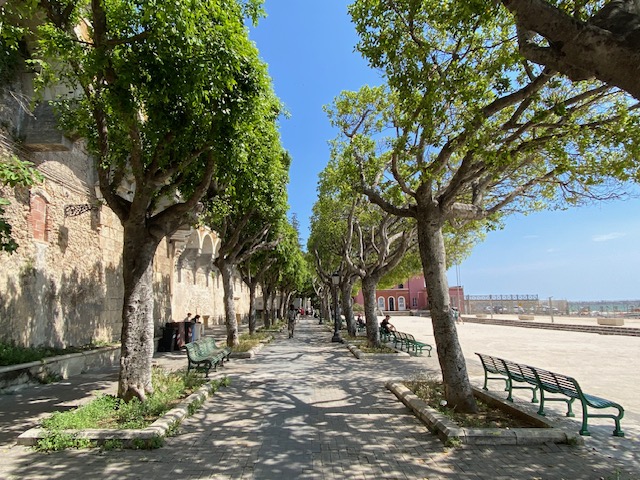
We’d originally timed our departure for 0800 to coincide with the tide change and associated current running south through the Messina Strait, but leaving earlier meant a slight current against us, which, fortunately, wasn’t enough to slow us down drastically. It certainly helped when the tide changed, though, assisted by a light breeze out of the east; neither enough for us to sail unfortunately, which meant we were motor-sailing again, then motoring when the wind dropped entirely.
Considering our state of sleep deprivation, before long Elaine needed a nap, surfacing around 1000, following which it was Roy’s turn to get some shuteye.
By noon the sun was trying to peek through overcast skies and Roy had finished his watermaker duties, but we’d encountered a number of obstacles in the water, requiring vigilance at all times. These included floating trees, large pieces of timber and, of course, motoryachts not paying attention and not watching where they were going, but all in one hell of a hurry, as usual.
By 1530 we were anchored in a large protected bay off Syracuse. Besides our failed attempt at finding the fuel dock, indicated on Navionics, to get diesel, given all our motoring, we were delighted to find a calm anchorage with good holding and plenty of swing room. Heaven!
Once we were settled, Elaine finished her blog after our explorations of Taormina and Castelmola yesterday, while Roy went on a reconnaissance to find a fuel dock, somewhere to dispose our garbage and somewhere safe to leave the dinghy for when we go exploring again, as well as taking the opportunity to enjoy a cold beverage at one of the waterfront bars while chatting to Keenan.
One his return, he was delighted to report that he found everything we needed, including a very friendly, welcoming marina manager, who indicated it was no problem at all to leave our dinghy in the marina. What a change from Greece!
And, on that positive note our day came to a close.
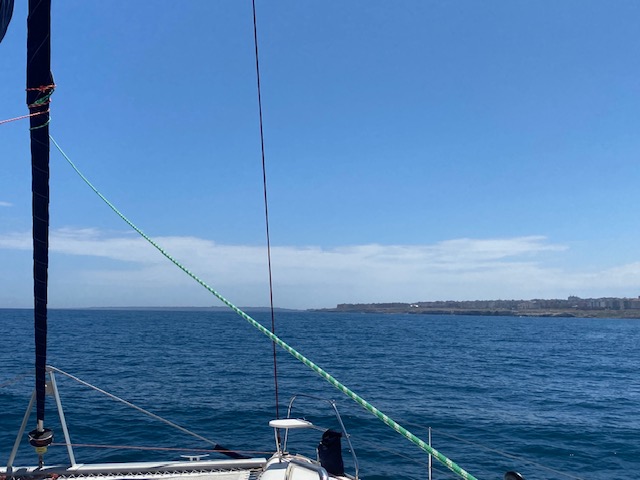




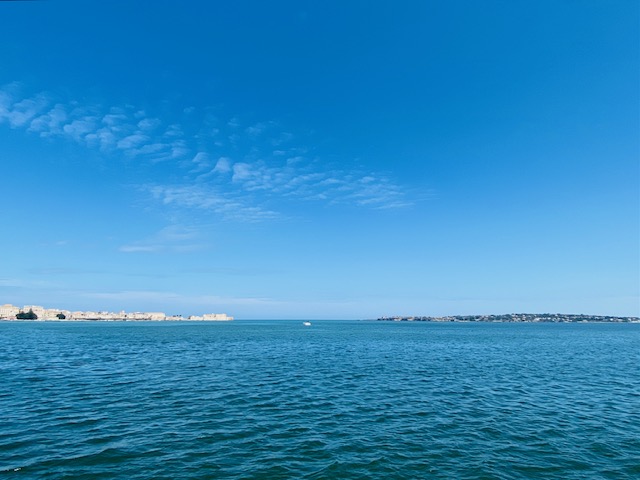




Choosing to actually get off the bus this time, the route took us to Taormina, a beautiful mountaintop city and then to Castelmola, perched even higher on an even higher mountain top, with Mount Etna as the backdrop. Having seen both settlements at a distance following our arrival yesterday, we were excited to explore them, not realising they were both top tourist destinations in Sicily; it was the crowds that gave this particular fact away. We hadn’t seen this many people congregated in one area since the Chinese New Year 2020 in Penang, Malaysia, just weeks before the world was brought to its knees with the COVID-19 pandemic, but what a fabulous outing we had.
Passing the conically-shaped “Chiesa Parrocchiale Santa Maria Immacolata (San Giovanni Battista)” (Church of Saint Mary Immaculate (Saint John) in Grandini / Naxos and the village of Villagonia as the bus took us along the coastal road around the Naxos Bay, we then turned inland and started the ascent. Not only were the views breathtaking, but so too were the heights we reached, as the driver skilfully negotiated the narrow little roads that switched this way and that, taking us higher and higher.
Reaching Taormina and starting our wanderings, we were amazed at the general architecture and aesthetics of the city, never mind some of the beautiful buildings we saw, particularly the churches.
Passing under the ornate Porta Messina (Messina Gate) gave us access to Corso Umberto, the main street of the city, a pedestrian walkway leading to “la piazza cittadina” (the city square), where we enjoyed musicians, in traditional dress, entertaining the crowds with their lively Italian music, including everyone’s favourite: “When the moon hits the sky like a big pizza pie, it’s amore”, made famous by Dean Martin.
As we strolled along the streets, we stopped at “Chiesa di Santa Caterina d'Alessandria” (Church of Saint Catherine of Alexandria), built in the first half of the 1600’s. The entrance portal is made of pink marble from Taormina and above it, in a niche, there is a statue of St. Catherine, sculpted in 1705. For some odd reason it also had a quirky little car parked outside. During our wanderings we were amazed numerous narrow side streets taking one up or down the mountainside by way of steps, the narrowest one being barely wide enough to fit a person.
From there we visited “Chiesa di San Giuseppe” (San Giuseppe Church), “Torre dell'Orologio e Porta di Mezzo” (Clock Tower and Porta di Mezzo) and “Sant' Agostino (Biblioteca)” (Sant' Agostino (Library)), the latter buildings positioned around “la piazza cittadina”, Piazza IX Aprile.
Taormina dates back to around 396 BC, after Dionysius I of Syracuse destroyed nearby Naxos in 403 BC and formed a new settlement on the nearby Mount Taurus, which gradually grew into the modern day city of Taormina. After the Italian unification, also known as the “Risorgimento”, the 19th-century movement which resulted in the Kingdom of Italy in 1861, Taormina began to attract well-off travellers, usually men from northern Europe, bringing Taormina to international attention. Famous figures included Oscar Wilde, Kaiser Wilhelm II, Philipp, Prince of Eulenburg and the wealthy and the well connected Florence Trevelyan, who is credited with bringing the variety of flora to the island.
Research revealed that the “Chiesa di San Giuseppe Chiesa di San Giuseppe” (San Giuseppe Church), is a beautiful Baroque style building, built in the second half of the 17th Century and dedicated to Saint Joseph.
“Torre dell'Orologio e Porta di Mezzo” (Clock Tower and Porta di Mezzo) is a medieval tower built in the 12th century on Greco-Roman foundations and is also a gate to the city. Due to its location, about halfway between Porta Messina and Porta Catania, along Corso Umberto, the tower is also known as “Torre di Mezzo” (Middle Tower) or “Porta di Mezzo” (Middle Gate) and actually separates the medieval part of the town from the ancient Greco-Roman part.
By noon it was time to return to the bus stop to head further up the mountain range to Castelmola, where the drop off tested anyone who is afraid of heights, as Elaine is, but also had Roy commenting at the sheer drop as we approached the guardrails to enjoy the spectacular views. From there we wandered through the little town, much smaller than Taormina, to enjoy lunch at the Turrisi restaurant, situated on a small piazza, with a peculiar drinks menu, not for what was on it, but rather its shape and where we also enjoyed the views overlooking the imposing Mount Etna, not realising the mountain sprinkled with snow this morning, explaining the chill in the air, was, in fact, the famous volcano that spewed smoke a few weeks ago. It was right under our noses!
While Roy ordered pizza for lunch, Elaine paid a visit to “Chiesa San Nicolo di Bari Duomo” (Church of Saint Nicholas of Bari), rebuilt between 1934 and 1935 on the site of the original sixteenth-century church, from which the side portal and the arch of the choir have been reassembled, as well as the altars and the pulpit in inlaid walnut, dating back to the eighteenth century.
Our return journey took us through all the little villages lining the coast north of where we were anchored, including Letojanni, Mazzaro and Isolabella, all providing beautiful seascapes and countryside views too, before returning us to Giardini / Naxos, where we enjoyed an afternoon coffee then made our way back to Paw Paw.
What struck us on our return trip, however, was the engineering feat it took to build the roads, bridges and tunnels down the mountains and, indeed, through the mountains, as we balanced on roads hanging over the cliffs, held up by concrete pillars and drove through numerous tunnels carved out of the rockface. It certainly cemented the civil engineering skills of the Italians in our minds.
Today had been a day of wonder in more ways than one and all that was left was to endure another night in a very rolly anchorage. It was rather comical, though, to watch yacht after yacht arrive and anchor on top of the fool who had dissuaded us to anchor near him by erroneously indicating where his anchor was; don’t you just love karma!
After a reasonably good night’s sleep, given how rolly the anchorage was, we surfaced around 0900, had breakfast, beached the dinghy, with help from a very friendly fisherman, and reached street level just as a Hop On Hop Off bus arrived. Not realising there was a Hop On Hop Off service running, we had planned on walking along the waterfront, but decided this was a much better alternative, delighted at our perfect timing; we couldn’t have planned it better if we tried.
Choosing to actually get off the bus this time, the route took us to Taormina, a beautiful mountaintop city and then to Castelmola, perched even higher on an even higher mountain top, with Mount Etna as the backdrop. Having seen both settlements at a distance following our arrival yesterday, we were excited to explore them, not realising they were both top tourist destinations in Sicily; it was the crowds that gave this particular fact away. We hadn’t seen this many people congregated in one area since the Chinese New Year 2020 in Penang, Malaysia, just weeks before the world was brought to its knees with the COVID-19 pandemic, but what a fabulous outing we had.
Passing the conically-shaped
“Chiesa Parrocchiale Santa Maria Immacolata (San Giovanni Battista)” (Church of Saint Mary Immaculate (Saint John) in Grandini / Naxos and the village of Villagonia as the bus took us along the coastal road around the Naxos Bay, we then turned inland and started the ascent. Not only were the views breathtaking, but so too were the heights we reached, as the driver skilfully negotiated the narrow little roads that switched this way and that, taking us higher and higher.
Reaching Taormina and starting our wanderings, we were amazed at the general architecture and aesthetics of the city, never mind some of the beautiful buildings we saw, particularly the churches.
Passing under the ornate Porta Messina (Messina Gate) gave us access to Corso Umberto, the main street of the city, a pedestrian walkway leading to “la piazza cittadina” (the city square), where we enjoyed musicians, in traditional dress, entertaining the crowds with their lively Italian music, including everyone’s favourite: “When the moon hits the sky like a big pizza pie, it’s amore”, made famous by Dean Martin.
As we strolled along the streets, we stopped at “Chiesa di Santa Caterina d'Alessandria” (Church of Saint Catherine of Alexandria), built in the first half of the 1600’s. The entrance portal is made of pink marble from Taormina and above it, in a niche, there is a statue of St. Catherine, sculpted in 1705. For some odd reason it also had a quirky little car parked outside. During our wanderings we were amazed numerous narrow side streets taking one up or down the mountainside by way of steps, the narrowest one being barely wide enough to fit a person.
From there we visited “Chiesa di San Giuseppe” (San Giuseppe Church), “Torre dell'Orologio e Porta di Mezzo” (Clock Tower and Porta di Mezzo) and “Sant' Agostino (Biblioteca)” (Sant' Agostino (Library)), the latter buildings positioned around “la piazza cittadina”, Piazza IX Aprile.
Taormina dates back to around 396 BC, after Dionysius I of Syracuse destroyed nearby Naxos in 403 BC and formed a new settlement on the nearby Mount Taurus, which gradually grew into the modern day city of Taormina. After the Italian unification, also known as the “Risorgimento”, the 19th-century movement which resulted in the Kingdom of Italy in 1861, Taormina began to attract well-off travellers, usually men from northern Europe, bringing Taormina to international attention. Famous figures included Oscar Wilde, Kaiser Wilhelm II, Philipp, Prince of Eulenburg and the wealthy and the well connected Florence Trevelyan, who is credited with bringing the variety of flora to the island.
Research revealed that the “Chiesa di San Giuseppe Chiesa di San Giuseppe” (San Giuseppe Church), is a beautiful Baroque style building, built in the second half of the 17th Century and dedicated to Saint Joseph.
“Torre dell'Orologio e Porta di Mezzo” (Clock Tower and Porta di Mezzo) is a medieval tower built in the 12th century on Greco-Roman foundations and is also a gate to the city. Due to its location, about halfway between Porta Messina and Porta Catania, along Corso Umberto, the tower is also known as “Torre di Mezzo” (Middle Tower) or “Porta di Mezzo” (Middle Gate) and actually separates the medieval part of the town from the ancient Greco-Roman part.
By noon it was time to return to the bus stop to head further up the mountain range to Castelmola, where the drop off tested anyone who is afraid of heights, as Elaine is, but also had Roy commenting at the sheer drop as we approached the guardrails to enjoy the spectacular views. From there we wandered through the little town, much smaller than Taormina, to enjoy lunch at the Turrisi restaurant, situated on a small piazza, with a peculiar drinks menu, not for what was on it, but rather its shape and where we also enjoyed the views overlooking the imposing Mount Etna, not realising the mountain sprinkled with snow this morning, explaining the chill in the air, was, in fact, the famous volcano that spewed smoke a few weeks ago. It was right under our noses!
While Roy ordered pizza for lunch, Elaine paid a visit to “Chiesa San Nicolo di Bari
Duomo” (Church of Saint Nicholas of Bari), rebuilt between 1934 and 1935 on the site of the original sixteenth-century church, from which the side portal and the arch of the choir have been reassembled, as well as the altars and the pulpit in inlaid walnut, dating back to the eighteenth century.
Our return journey took us through all the little villages lining the coast north of where we were anchored, including Letojanni, Mazzaro and Isolabella, all providing beautiful seascapes and countryside views too, before returning us to Giardini / Naxos, where we enjoyed an afternoon coffee then made our way back to Paw Paw.
What struck us on our return trip, however, was the engineering feat it took to build the roads, bridges and tunnels down the mountains and, indeed, through the mountains, as we balanced on roads hanging over the cliffs, held up by concrete pillars and drove through numerous tunnels carved out of the rockface. It certainly cemented the civil engineering skills of the Italians in our minds.
Today had been a day of wonder in more ways than one and all that was left was to endure another night in a very rolly anchorage. It was rather comical, though, to watch yacht after yacht arrive and anchor on top of the fool who had dissuaded us to anchor near him by erroneously indicating where his anchor was; don’t you just love karma!
